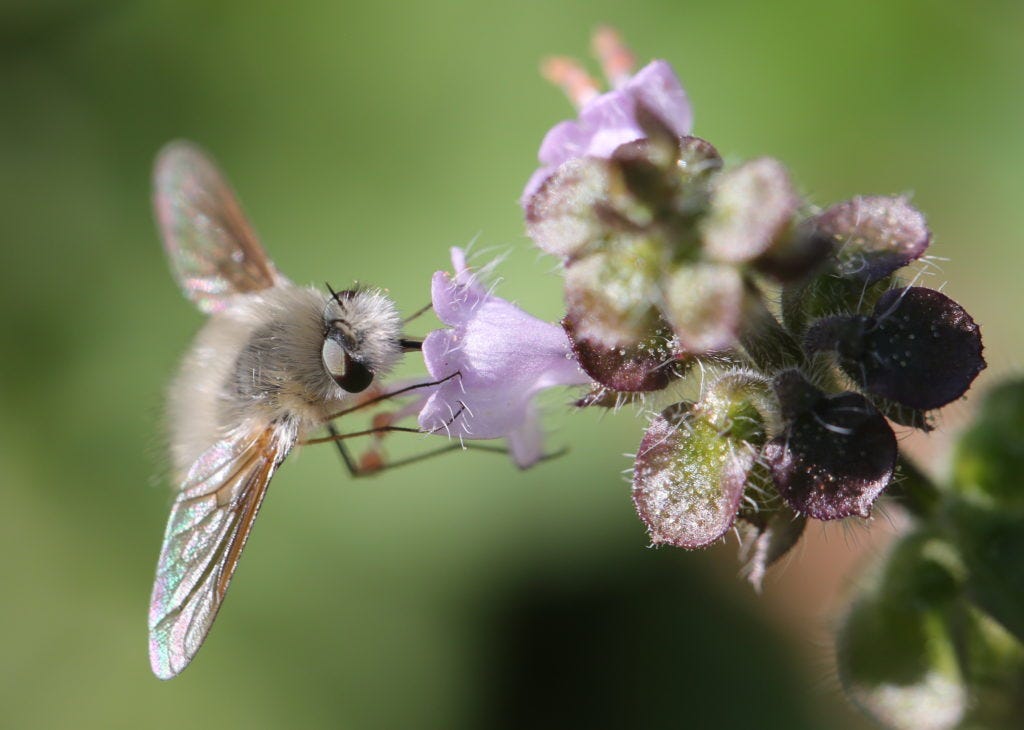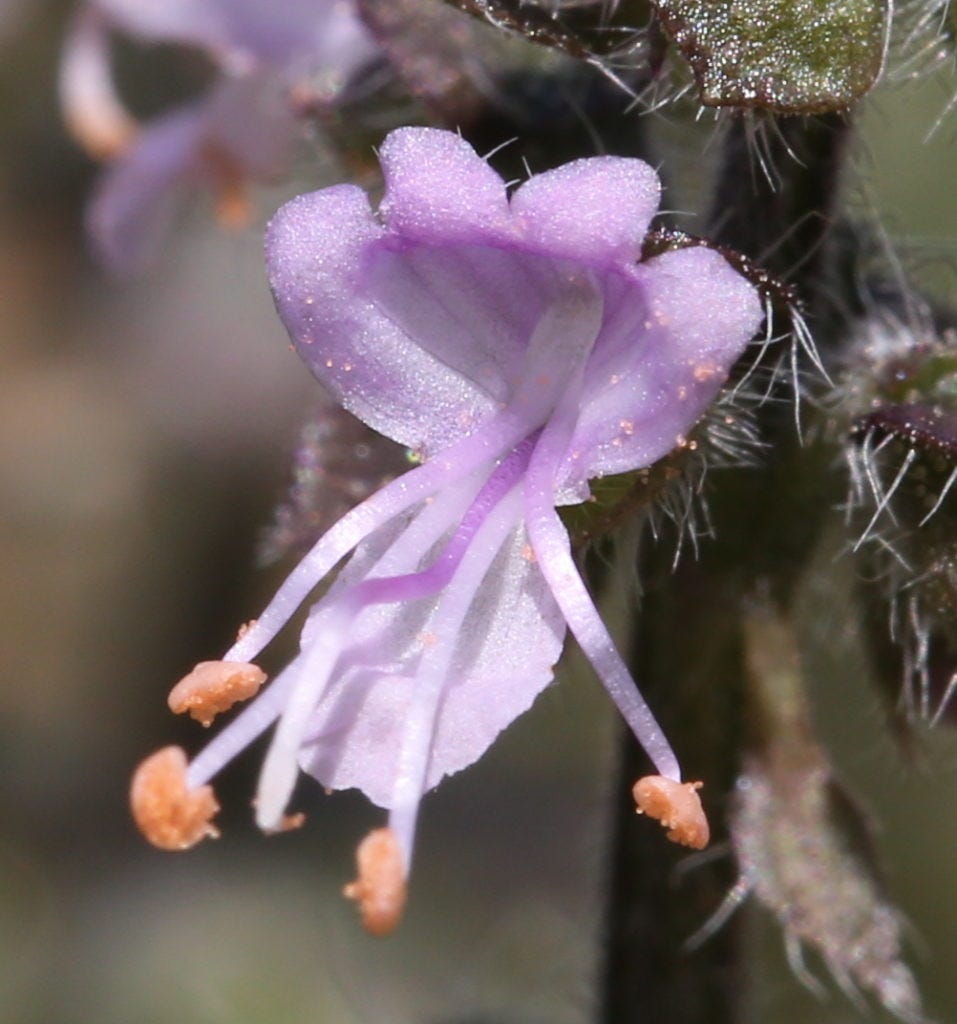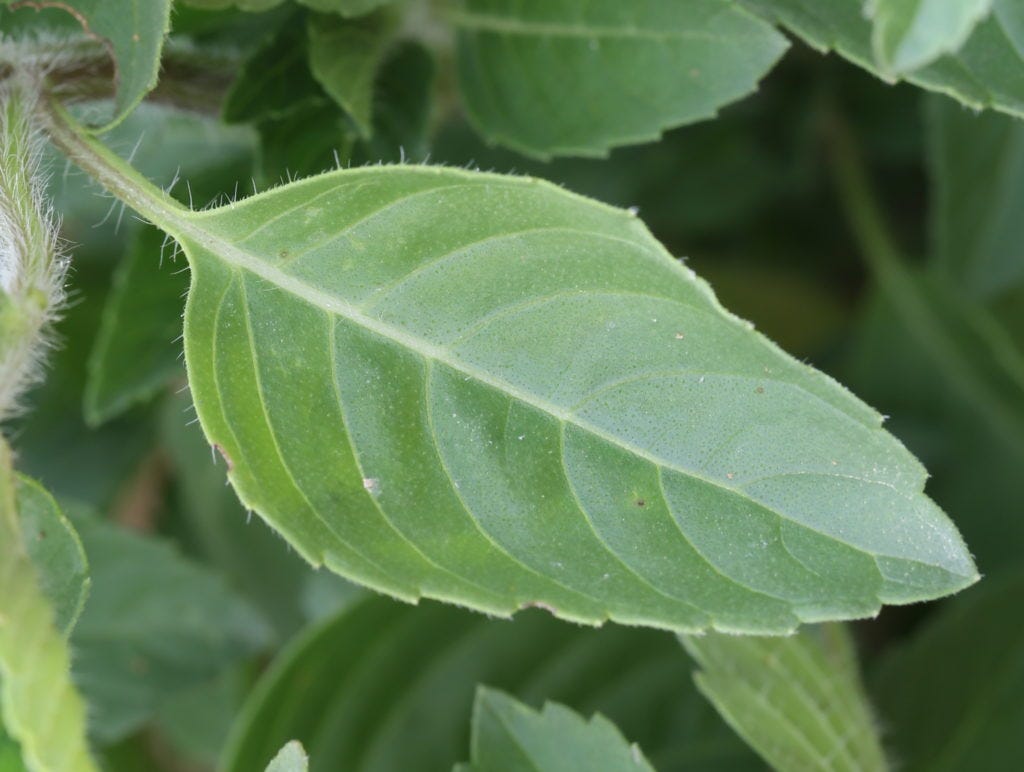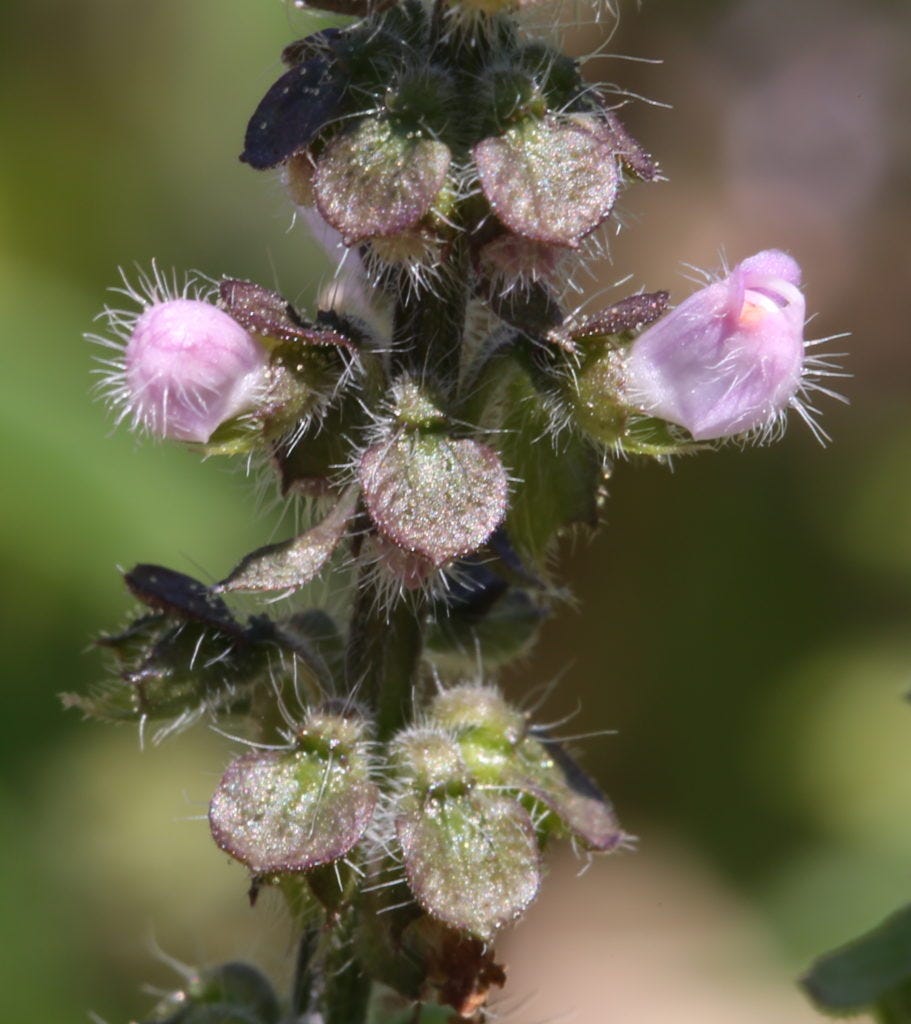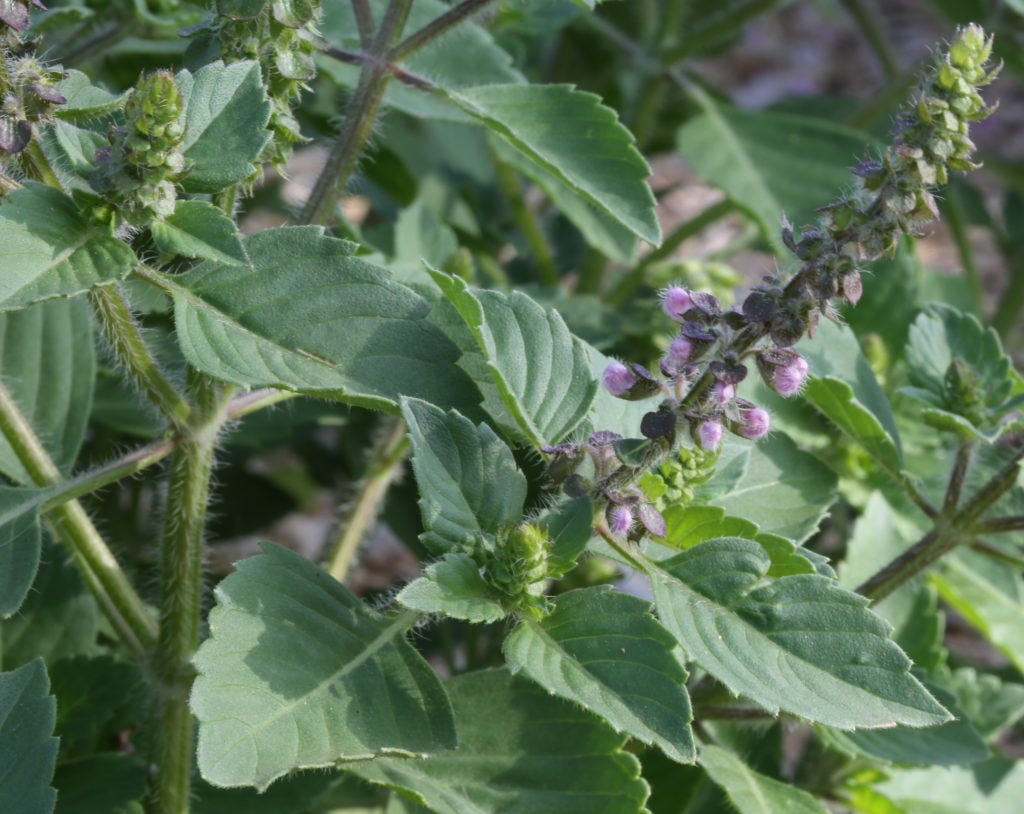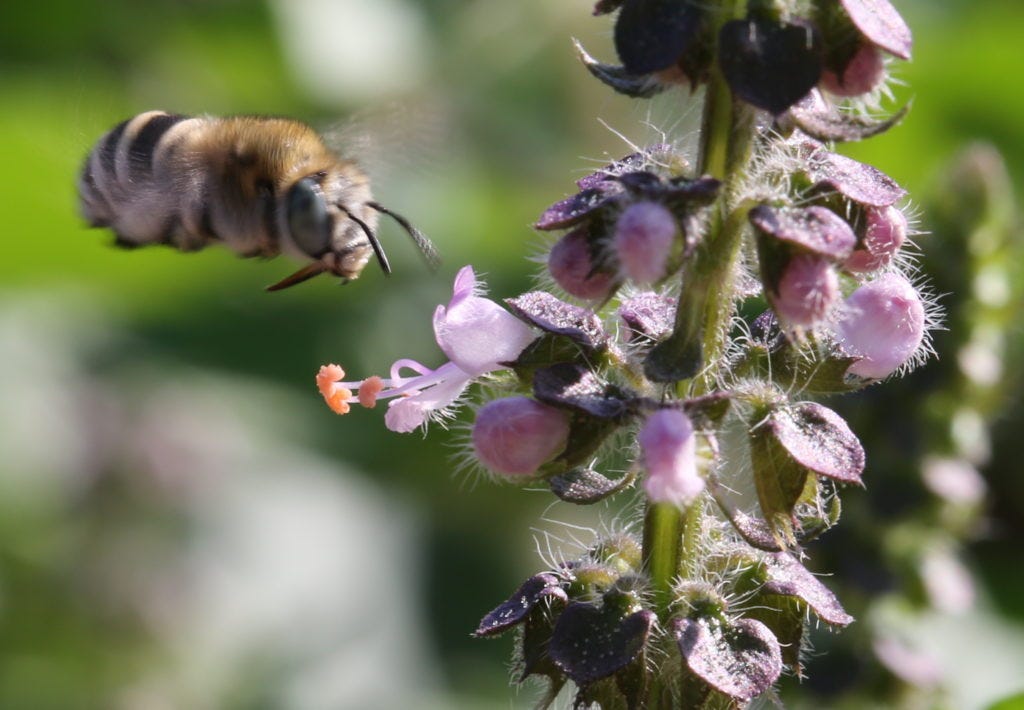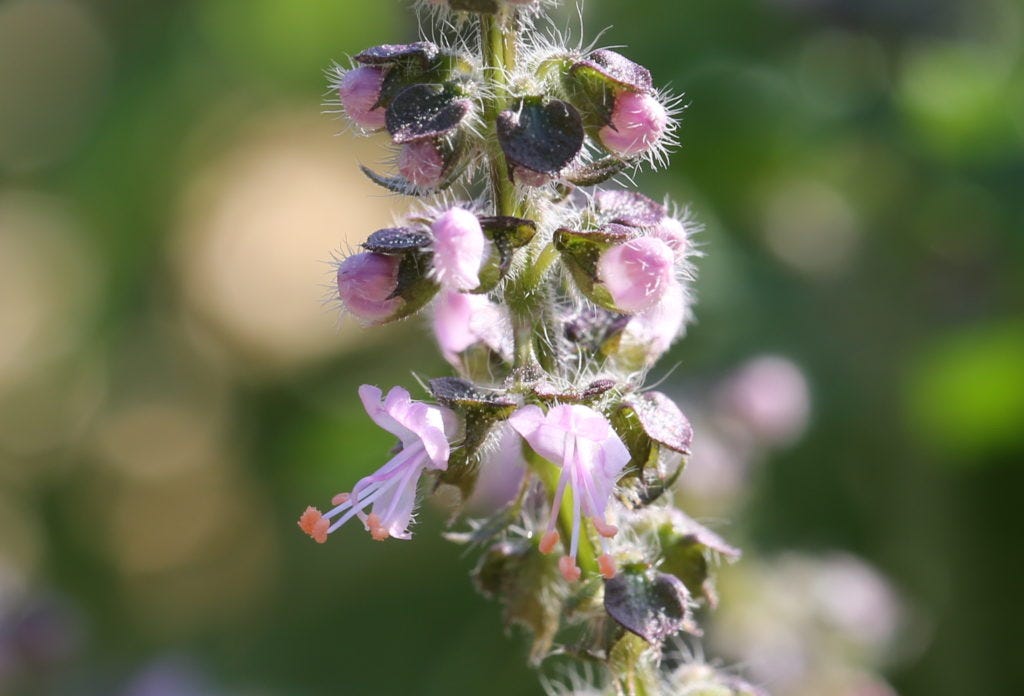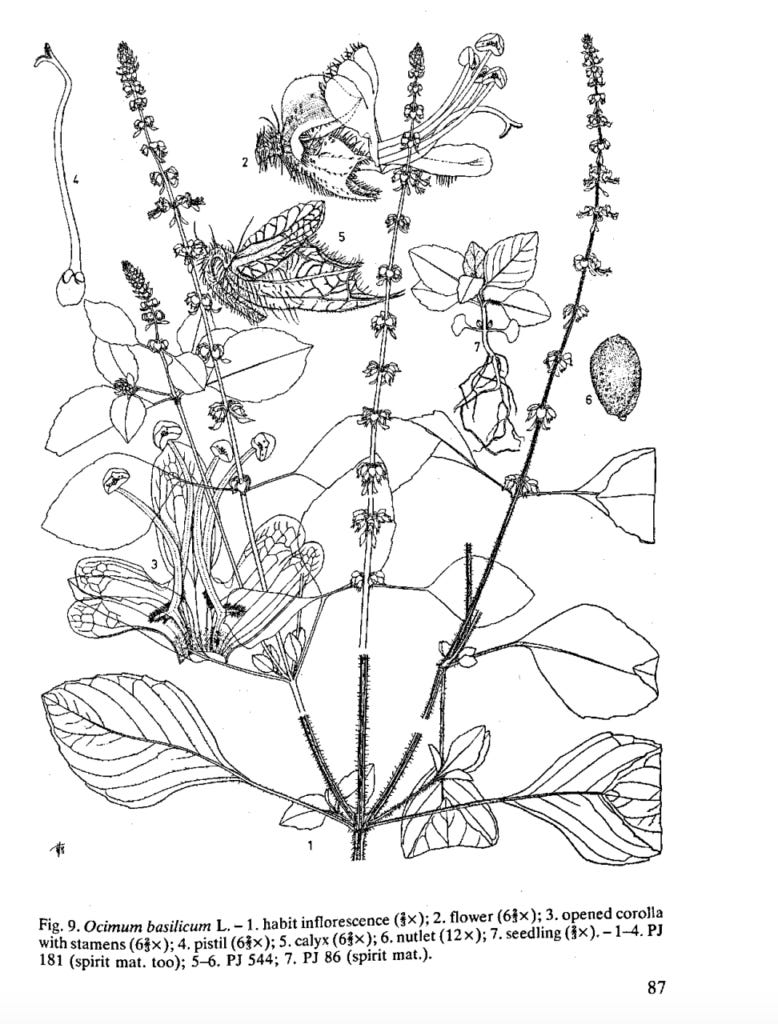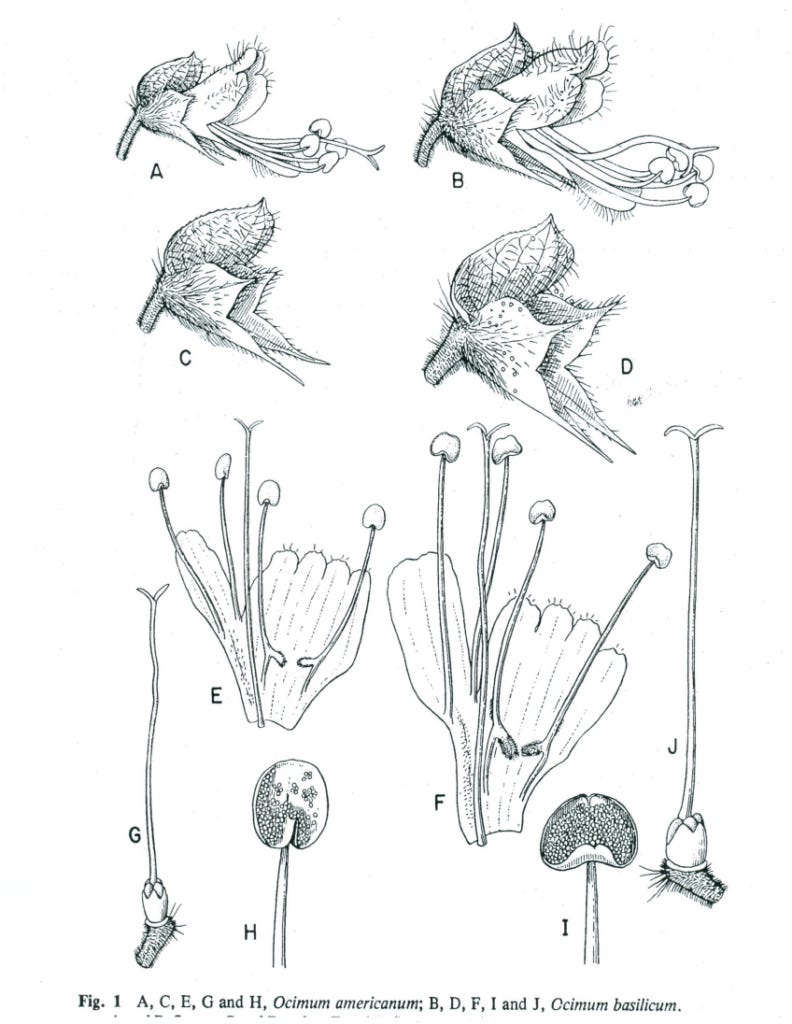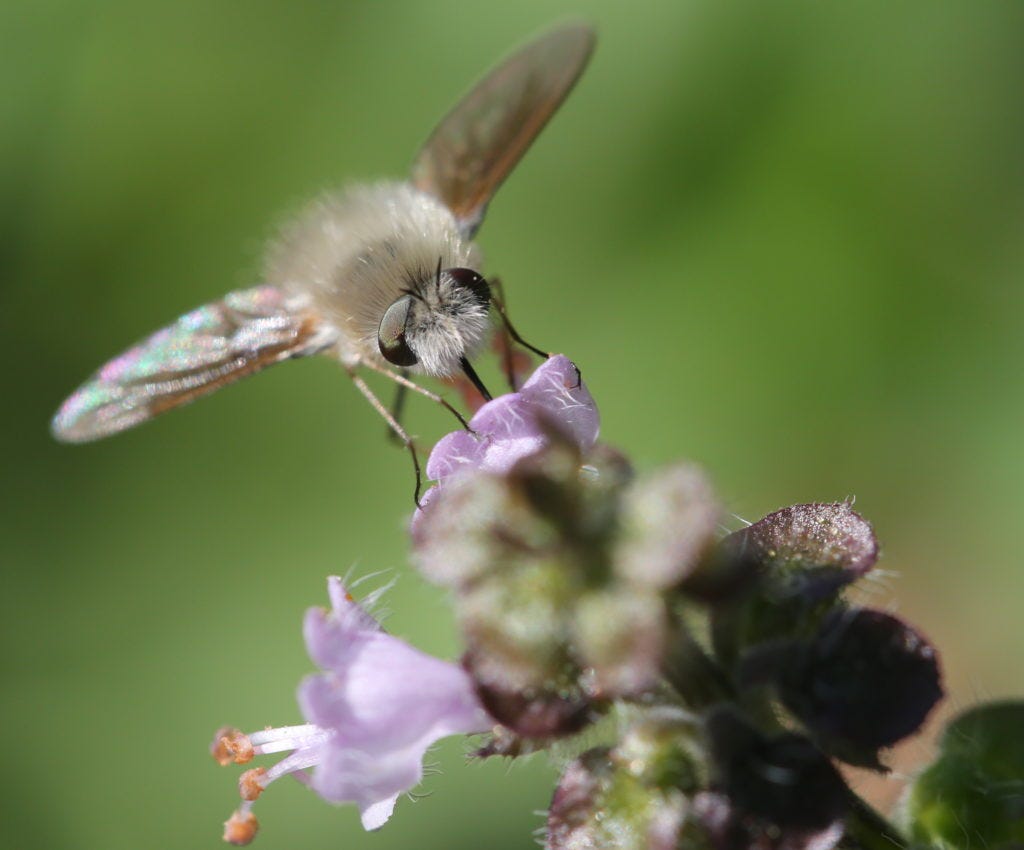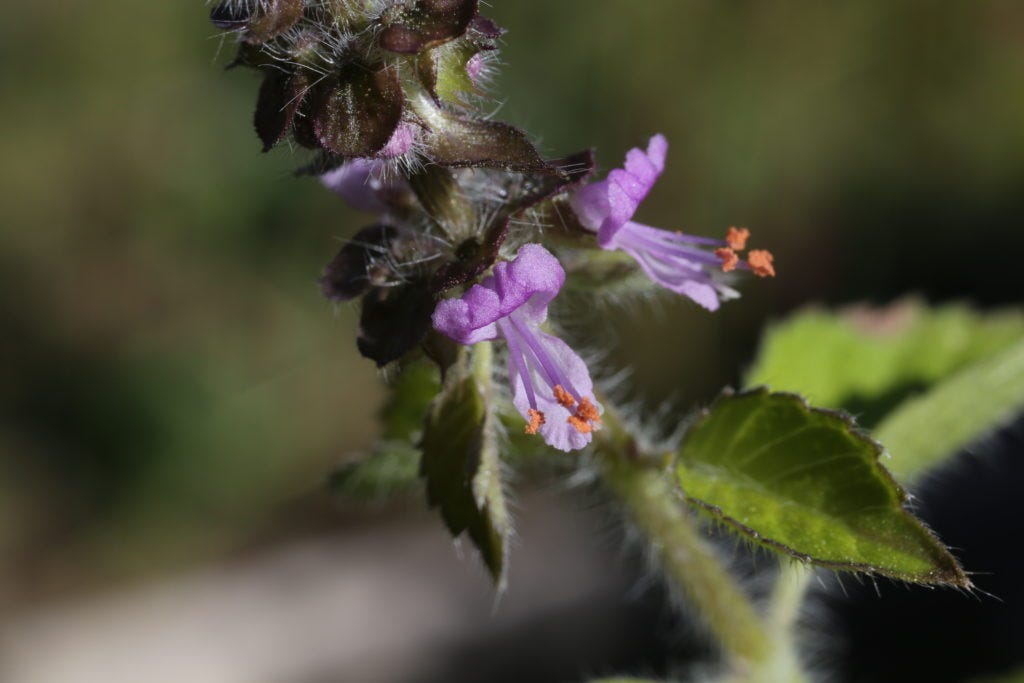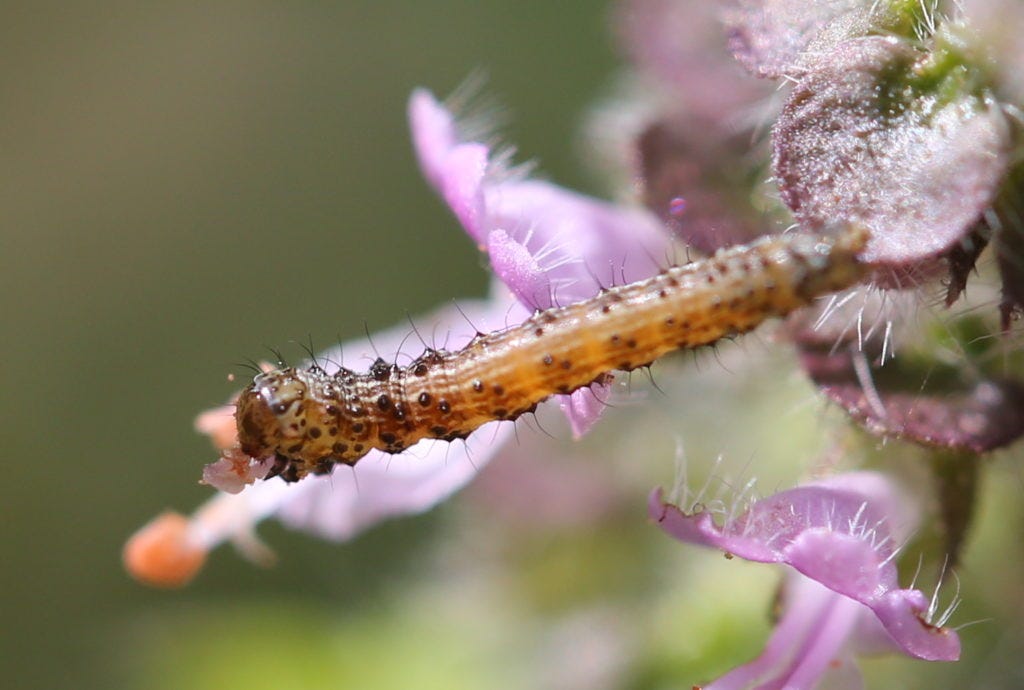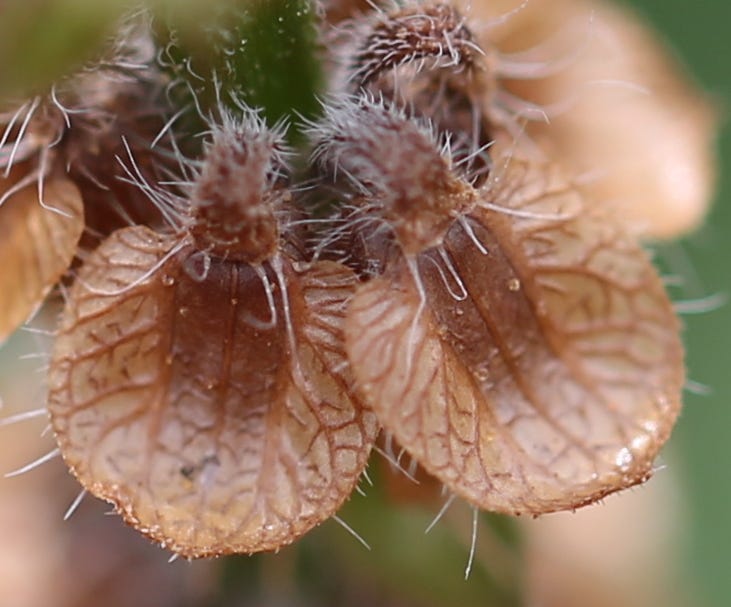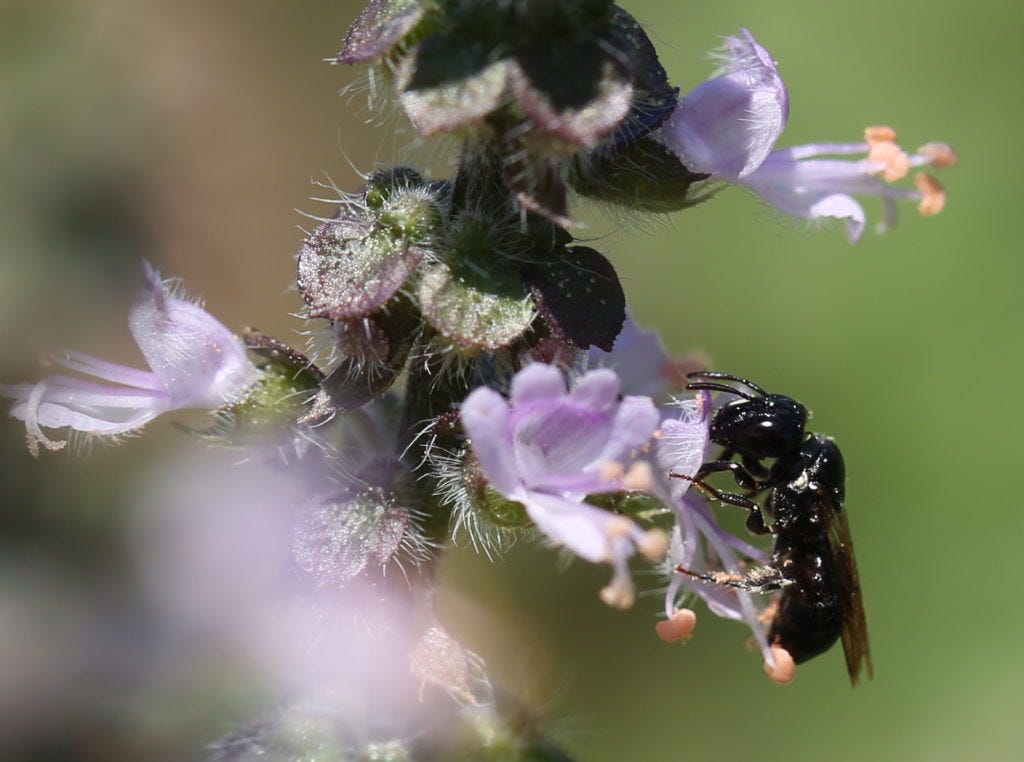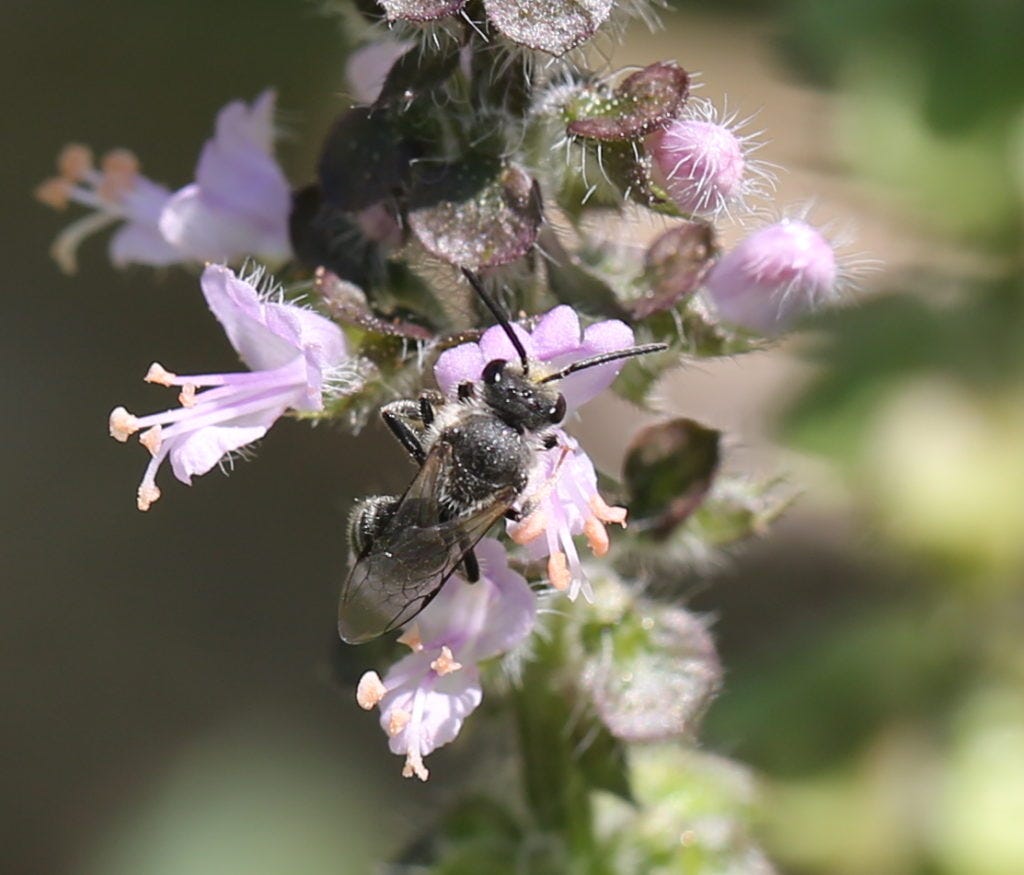Ethiopia is the source of the temperate Tulsi with its spicy scent of vanilla and myrrh… and red pollen
Caveat. My prose is non-conventional and spoken from a multi-scoped vision. I am writing under the influence of the Green’s crystals and under many atmospheric influences - and nowadays, the Muses and Dakinis are very fierce and angry. Why? Because the Alert is Biological.
Thus, the original versions of these present few essays, in English, are in two colours: black for the main text and mauve for the inclusions… which, sometimes, are more abundant.
The original bi-colored version of this essay “Ethiopia is the source of the temperate Tulsi with its spicy scent of vanilla and myrrh… and red pollen” is here.
This present version, on Substack, has not be modified… as I have no time to do so presently.
Caveat. As of November 19 th 2023, I brought a plethora of new informations, to this monograph published in August 2022, concerning Ocimum bisabolenum… because I made a lot of discoveries… which are, very often, calling for new discoveries! Moreover, I pushed my-self (or one of them) to get more serious, meaning hooked, with LinkedIn, because, otherwise, it is mainly impossible to communicate with the many scientists, all over the world, who have published scientific, so-called peer reviewed, studies with authentic conclusions except for the identity of the Ocimum ecotypes they were analysing. Why? Because they were dealing with Ocimum bisabolenum and not Ocimum tenuiflorum, neither Ocimum americanum nor Ocimum kilimandsharicum.
By the way, a lot of these studies were based on botanical samples which had been, supposedly, “authenticated” by “PhD botanical experts”… which says a lot about the state of Botanical Science “in vivo” – nowadays. Or about the state of Genetic Resources Conservation… as this botanical Ocimum chaos has been disseminated by the GRIN/USDA seed bank for the past 40 years or more – in fact, since the organic seed companies started to disseminate this wonderful, and non tropical, Sacred Tulsi prospering, with generosity, in the gardens of north America and Europe. I introduced, myself, in France, in 1994, this Sacred Tulsi which is today Ocimum bisabolenum – with the first organic seed catalogue of my, then, small seed company “Terre de Semences”.
In conclusion, a huge amount of studies, published during the last 40 years – about Ocimum tenuiflorum, Ocimum americanum, Ocimum kilimandsharicum and Ocimum basilicum – should be retracted.
Plainly! Which explains why nobody dared to answer me, last year, when I published “Ethiopia is the source of the temperate Tulsi with its spicy scent of vanilla and myrrh… and red pollen”.
Thus, I shall publish, very soon, an open letter to denounce the fake science surrounding this Ocimum bisabolenum – and its fate – for more than 40 years.
Since the first publication of this monograph, I concluded my first sequence of 7 medicinal monographs involving Ocimum species – namely Ocimum americanum, Ocimum basilicum, Ocimum kilimandsharicum, Ocimum gratissimum, Ocimum tenuiflorum, Ocimum selloi and, of course, Ocimum bisabolenum. In French.
Summary
Declaration of Intention with regard to the Tulsi of Ethiopia
A Temperate Tulsi of Unknown Origins
About the temperate Tulsi ecotypes, with red pollen, listed as Ocimum tenuiflorum in the USDA seed bank… or by Western seed companies
About the temperate Tulsi ecotypes, with red pollen, listed as Ocimum americanum in North America and Asia
A Tempered Tulsi with spicy, woody, myrrh scents… in Bisabolene mode
Bissabol, Bissa Bol and Bisabolenes
Abundance of Bisabolenes in “Sacred” Ethiopian Basils: Could the temperate Tulsi, with its red pollen, be of Ethiopian origin?
Bisabolenes in other species of Ocimum… or botanical misidentifications?
Medicinal Properties of Ethiopian Tulsi and Bisabolenes
Resistance of Ethiopian Tulsi to Basil Blight, Peronospora belbahrii
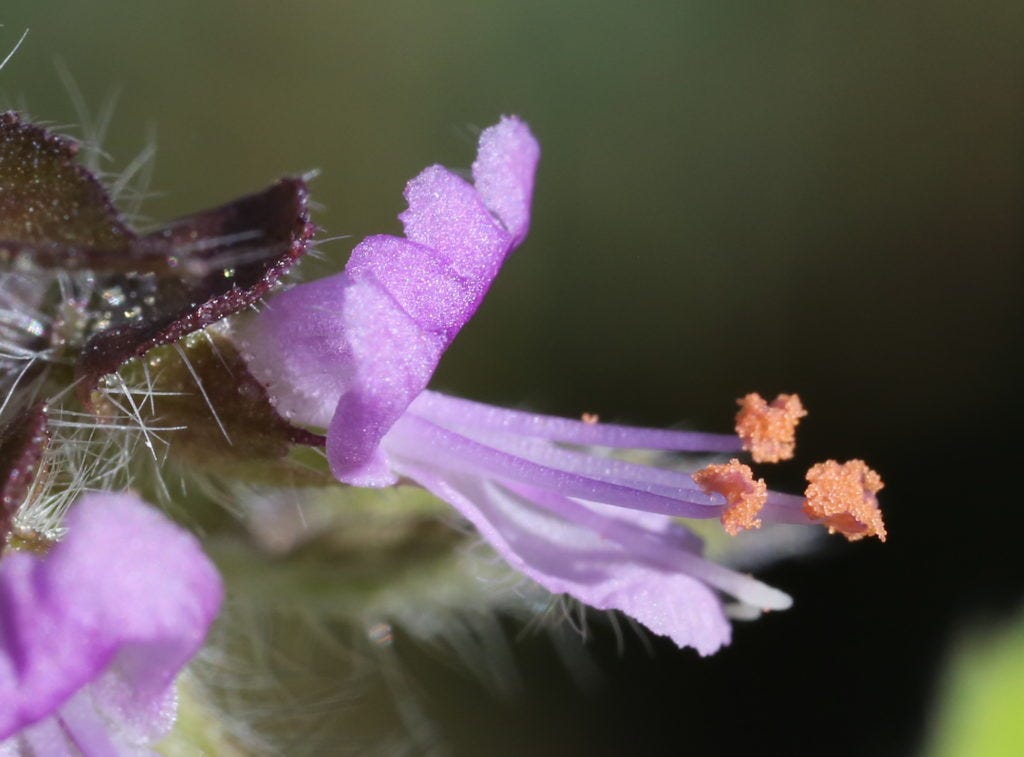
Picture of Ocimum bisabolenum. Sacred Basil from Ethiopia. Master Medicinal Plant. It grows on the Ethiopian plateau at 2000/2500 meters of elevation. This sacred basil is one of the ingredients of the Berber sauce and one of the plants used to preserve the clarified butter for up to 15 years.
«Tulsi Tulana Nasti Ataeva Tulasi».
Tulsi is Incomparable… in the sense that she cannot be compared to anything else. Because of this attribute, she is a manifestation of the Heavenly Mother on Earth.
Declaration of Intention with regard to the Tulsi of Ethiopia
My stated and open intention, in this new medicinal monograph, is to present this jewel of the Ocimum world that constitutes the temperate Tulsi, originating from Ethiopia: its origins, its perfumes, its composition, its dissemination in America and Europe, its presence in the Himalayan zones, the botanical marasmus that correlates to it, its integral resistance to the basil blight and its extremely medicinal qualities as well as those of the Bisabolene, its major chemotype.
With this statement of intent, I am already exposing my discovery of the source of the temperate Tulsi – namely, Ethiopia – which took me three weeks of extensive investigation and constant reworking and lengthening of my original text published on August 26… due to the number of discoveries that emerged – as each discovery called for another. And this, while writing a good part of the next monograph that I will, soon, publish in view of the extremely medicinal qualities of Ocimum americanum – in its two subspecies.
This declaration of intent is thus placed as a foreword, from a didactic point of view – and from an ethic of transparency – but, in fact, it constitutes the fruit of a whole quest and a whole path… namely, of two and a half months of investigations, and of writing, daily, on the major species of Ocimum.
These assiduous investigations allowed me to get out of the nomenclature and taxonomy morass surrounding, happily, the Ocimum species from an official botanical point of view as well as from a seed company point of view – organic or conventional. In the USA, for example, I have informed some seed companies, six years ago, that the temperate Tulsi is, strictly speaking, not an Ocimum tenuiflorum… but let the winds blow – which can, at times, become extravagant when the Great Solar Minimum begins to take hold in the heart of the Earth’s atmosphere. For how many decades?
My stated intention is, also, to argue for the attribution of species status to Temperate Tulsi, native to Ethiopia – with its exotic and intense fragrance, red pollen and compact habit.
If it is not, already, to pay homage to this botanical singularity that constitutes the temperate Tulsi native of Ethiopia – because it deserves it, existentially – and to pay homage to the Mother who emanated its matrix from Her Dreamtime.
If I may offer my testimony as an organic seed grower with 30 years of experience: we have never identified spontaneous crosses in the seed crops of our Temperate Tulsi ecotype (whose source is Abundant Life Seed Foundation) – and we have never heard of such spontaneous crosses from other seed growers.
And this is probably a pity. Indeed, it would be an enormous privilege to identify a natural hybrid between Temperate Tulsi and a variety of Ocimum basilicum… because it would mean that the mildew resistance of the former could be transmitted to the latter.
If the most official attribution, since 1999 – both for the temperate Tulsi and for the temperate Besobila of Ethiopia – has been to attribute to it the species Ocimum americanum (or Ocimum africanum), this does not make sense because of the strict absence of spontaneous crosses between this temperate Tulsi and other ecotypes of Ocimum americanum sp. pilosum or Ocimum americanum sp. americanum.
It would be very instructive if Ethiopian botanists could inquire about the possibilities of spontaneous crosses between Besobila and other ecotypes of Ocimum americanum sp. pilosum or Ocimum americanum sp. americanum growing in Ethiopia. A priori, it would be enough to request information from those who, in the highlands, have lived in synergy with Besobila… for thousands of years.
In conclusion. If the origin of the temperate Tulsi is clearly determined, and relatively localized – namely Ethiopia. If its morphological characteristics are particularly unique – compact habit, fast growth, very high bio-mass production, low essential oil production, high resistance to cold, perennial character; if its chemotype is very often Bisabolene and if its fragrance is embalming.
According to Simon’s 1999 study, “Basil: A Source of Aroma Compounds and a Popular Culinary and Ornamental Herb”, the 40 Ocimum ecotypes studied flowered from 72 days to 134 days after sowing. The temperate Tulsi ecotype “Spice” was among the first 5 ecotypes to flower at 76 days – the same time frame as the Ocimum americanum sp. pilosum ecotypes.
And, more importantly, if no testimony of seed producers has evoked spontaneous crosses with other Ocimum species for about forty years… wouldn’t it be reasonable to grant it a species status?
Today, if I were asked to determine the species of Ocimum closest to the temperate Tulsi – among the most known worldwide – I would answer, without a doubt, Ocimum kilimandscharicum, the Tulsi of Kilimanjaro… from a sensory and intuitive point of view.
The highlands of Ethiopia, as the crow flies, are not far from Kilimanjaro – which borders Tanzania and Kenya. Both regions share the same temperate conditions of medium and high altitude.
Moreover, it should be noted that Klaudija Carovic – in her study, in Croatia, analyzing 4 ecotypes of temperate Tulsi instead of Ocimum tenuiflorum – has made it very clear that there were incongruities in the results of her analyses: «In the NJ tree and MP tree, two incongruences, concerning the O. basilicum “Erevanskii” (06) accession and O. kilimandscharicum (17) accession, could be noted.… On the MP tree, Ocimum kilimandscharicum was clustered together with O. tenuiflorum accessions also as a sister taxon.» [21]
Thus, according to the conclusions of Klaudija Carovic, the four ecotypes of temperate Tulsi analyzed are, genetically speaking, the closest to Ocimum kilimandscharicum.
Regarding the ecotype of Ocimum basilicum, “Erevanskii” – as I mentioned in my monograph on Ocimum americanum – it is one of the two purplish ecotypes from Russia that are, obviously, Ocimum americanum… and that is why they appear, according to Klaudija Carovic’s findings, in the Ocimum americanum clade. In his 2017 study, “Morphological and biochemical intraspecific characterization of Ocimum basilicumi” ,“Erevanskii” and a second Russian ecotype of purple basil, (S60 and S63), appear, again, in a separate clade. [102]
Thus, would it not be reasonable – just from a Cartesian point of view – to imagine that a single species, namely the temperate Tulsi (with red or white pollen) could have emanated from the Ethiopian highlands… when these concentrate two thirds of the mountainous massifs of Africa?
From a Gaian point of view, the emanation of a species (or its longevity) has nothing to do with the amplitude of a territory, in fact. I know of a species of dwarf lupine that grows only on the summit of Mt. Ashland in Oregon. [74] Similarly, I know of a species of Eriogonum that only grows on a cliff north of Medford at Acker Rock, Oregon. [75] And more.
By the way, speaking of Eriogonum, and other wild Buckwheats, isn’t it disturbing that it took almost half a century for the status of the red-pollinated temperate Tulsi to be mentioned… when the single species Eriogonum umbellatum, in the USA, includes more than 40 subspecies – which are, frankly, sometimes not very similar. [80] I even discovered one, myself, on Mount Adams, Washington – according to the late James Reveal, the US Polygonaceae expert.
A status of species all the more so – oh so much more, according to the mythos of modern genetics – that the temperate Tulsi has its own specific weight of DNA (2843 Mbp) and that it is placed, by ad hoc genetic analyses, in a clade, totally, apart – as declined in a subsequent section.
And what would we call it? What about “Ocimum besobila”? Or, else, “Ocimum bisabolenum”?
A Temperate Tulsi of Unknown Origins
The temperate Tulsi with its spicy scent of vanilla, tutti-frutti, or myrrh – and its red pollen – has been offered commercially as organic seeds for a good forty years and I introduced it, myself, in France, as early as 1994, with Terre de Semences – the forerunner of the Kokopelli Association – under the name of “Sacred Basil”.
In fact, this Tulsi is one of the easiest to grow in temperate countries. It is “temperate” in terms of agricultural conditions… but not in terms of its fragrance which is very intense. By the way, currently, when I water my desert garden – at a rate of three good hours, daily, almost every day of the summer… because the storms turn and burst elsewhere! – this vanilla Tulsi is the only one, of the 30 types of Basil that I cultivate, to be noticed, from the nose, by releasing its strong perfume under the effect of the watering.
I had discovered this “Tulsi” in the Ali Baba’s Cave seed-catalog, of the non-profit organization, “Abundant Life Seed Foundation”, which possessed, then, 3000 varieties, or species, in seeds – largely organic – and which was consumed by an arson-induced fire in very suspect conditions, in 2003.
Abundant Life Seed Foundation was founded by Forest Shomer in Port Townsend and published its first seed catalog in 1974. I spoke with Forest several times, but he could not remember the origin of the temperate Tulsi that he had introduced to the organic gardening community on the West Coast of the USA – some 40 years ago.
But it is quite possible that I also got some seeds from my friend Mushroom – alias Alan Kapuler of Peace Seeds. Mushroom himself had originally received them from J. L. Hudson, Seedsman, from Honda in California – another catalog – of Ali Baba’s Cave type seeds. [81]
The plants of this Tulsi are compact, with a very branched habit: they are about 30/45 cm wide and 35 cm high at full bloom/fruiting. The leaves, well cut, and of dark green color, can reach 50 mm length, with a petiole 10 mm long – however, most of them are much smaller. The pale mauve flowers, 6 to 7 mm long, are sessile – that is, they have a very short peduncle. The interior of the corolla is completely glabrous. Four stamens – exserted, at full maturity, well beyond the corolla – produce a pollen of brick red color. The production of seeds is abundant and fast. The plant is characterized by a very great resistance to the cold of the autumn.
The bio-mass production is enormous and in some parts of Europe it is easy to produce a second crop in the same season – after having cut everything to 10 cm height in the first harvest. According to a study in Georgia, USA, mentioned below [53], the production of the various ecotypes of temperate Tulsi is almost double the various ecotypes of Ocimum tenuiflorum.
In the fall of 2016 – as I began, assiduously, to photograph a plethora of ecotypes and varieties of Ocimum – in order to enrich Kokopelli’s range of organic medicinal seeds – I pointed out that it could not be the species Ocimum sanctum/Ocimum tenuiflorum, native to India, because this Tulsi, very hardy to cold and very compact of port, is characterized, botanically, by pollen of brick red color and by very mucilaginous seeds when they are humidified. Moreover, the morphology of its flowers, as well as of its leaves, is different – strictly and totally – from that of Ocimum tenuiflorum.
Here are the species of Ocimum that have mucilaginous seeds. All species in the Ocimum subsection of the Ocimum section, of the genus Ocimum: Ocimum basilicum, Ocimum americanum, Ocimum kilimandscharicum, Ocimum forskolei, Ocimum fisheri, Ocimum kenyense and Ocimum citriodorum. Species of the section Gymnocymum: Ocimum campechianum and Ocimum ovatum.
As for Ocimum tenuiflorum, in the section Hyerocimum, its mucilage is considered much less abundant than that of the subsection Ocimum. Moreover, one of Alan Paton’s botanical keys mentions it with non-mucilaginous seeds.
Here are the species that do not have mucilaginous seeds. The species of the subsection Gratissimum of the section Ocimum: Ocimum gratissimum, Ocimum cufodontii, Ocimum jamesii, Ocimum mummularia, Ocimum spicatum, Ocimum urticifolium.
I, thus, alerted my friends and colleagues seed producers, in all the USA (in particular Richo of Strictly Medicinal Seeds, Mushroom of Peace Seeds, Frank Morton of Wild Garden Seeds, CR Lawn of Fedco, etc) as for the fact that the Ocimum, native of India, with red pollen, that we marketed, since tens of years, under the denominations “Holy Basil”, “Tulsi”, “Sacred Basil” – and, which was, then, marketed under the denominations “Spice” and “Blue Spice”… to make it spicier – was, “specifically” speaking, nothing of what some people called it… at the whim of botanical luck.
Richter’s Seeds, in Canada, has been selling it for a very long time under the name “Spice”. Moreover, this seed company does not take any risk, specific, because it presents it in Ocimum sp. – namely, an unspecified Ocimum. [9] I grew the “Spice” ecotype, sold by Richters’s twice, myself, and it is, without doubt or appeal, strictly, the temperate Tulsi.
Indeed, some named it “Kapoor”… while this denomination characterizes, strictly, Ocimum kilimandsharicum, in all India. It is true that this confusion can, easily, emanate from the fact that the temperate Tulsi, of unknown origin, and the Tulsi of Kilimanjaro, have, both, a pollen of brick red color. See, on this subject, my monograph entitled “Les Qualités Extrêmement Médicinales de la Tulsi du Kilimandjaro, Ocimum kilimandscharicum”.
To add to the botanical confusion, today, this Basil is still marketed under this name by dozens of seed companies in the USA. For example, under the name of Tulsi “Kapoor”, Ocimum africanum, by Johnny’s Seeds. [12] Or, as Tulsi “Kapoor”, Ocimum sanctum, by Southern Exposure Seed Exchange… and many other seed companies. [24]
Others named it “Tulsi Rama”… whereas this denomination characterizes, mainly, Ocimum tenuiflorum (in its green form) and, sometimes, according to some pharmacological investigations, Ocimum gratissimum – such as a 2015 study [30] on the anti-bacterial, and anti-fungal activities of Ocimum kilimandscharicum, Ocimum tenuiflorum and Ocimum gratissimum.
Some pharmacological investigations identified it as “Ocimum basilicum” while others as “Ocimum americanum” or, again, Ocimum americanum sp. pilosum” – according to James Simon’s 1999 study.
Today, Richo, from Strictly Medicinal Seeds, presents it as an “Ocimum africanum” [7]… which some botanists prefer to consider as a subspecies, namely “Ocimum americanum sp. pilosum”.
It should be noted, also – which does not facilitate indexing – that many authors use the specific name “Ocimum canum” to indicate any ecotype of Ocimum africanum – and, sometimes, of Ocimum americanum
Richo specifies, on his site, that a genetic analysis has identified it as such – Ocimum africanum. However, if one accepts this form of scientific mythos, which is modern genetics, then we must concede that the various forms of this temperate Tulsi, with red pollen, constitute a group apart, genetically speaking, from all varieties, or species, of Ocimum marketed.
What should we conclude from this – from a specific point of view?
Indeed, a 2013 Taiwanese study using molecular markers (random DNA amplification polymorphism) found [8] that the “Spice” and “Blue Spice” ecotypes constituted their own separate group. Namely, this Taiwanese study divided all analyzed ecotypes into four distinct groups:
The first group contained only Ocimum basilicum varieties.
The second group contained the varieties (or ecotypes) “Lemon”, “Lime”, “East Indian”, “Mrs. Burns” and “Sweet Dani” – which are considered to belong to Ocimum citriodorum… which, according to some, is an interspecific hybrid involving Ocimum basilicum and Ocimum americanum sp. pilosum. According to others [38], Ocimum citriodorum and Ocimum americanum sp. pilosum would constitute a single taxon given the strict proximity, not to say similarity, of the components of their essential oils, at least in certain ecotypes – namely: linalool, nerol, geraniol and citral… and sometimes bisabolene.
The third group contained the species Ocimum tenuiflorum.
The fourth group contained the “Spice” and “Blue Spice” ecotypes – that is, the temperate Tulsi with red pollen.
Moreover, this Taiwanese study clearly affirmed that there was no difference between the ecotypes “Spice” and “Blue Spice”. Moreover, the Canadian seed company, Richter’s Seeds, which previously marketed both, now only markets “Spice”.
However, this study continued (as did a number of researchers) to include these two ecotypes in the Ocimum basilicum species – while asserting that they were, indeed, exceedingly distant, genetically speaking, from all the rest of Ocimum basilicum… like the lemon ecotypes “Sweet Dani” and “Mrs Burn”.
In 2016, I became aware that no botanist had ever, really, looked into the subject of this temperate Tulsi – namely, to decline its specific nature and origins. I contacted Alan Paton of Kew Botanic Garden, who is an expert on Ocimum – and the author of many essays and botanical keys on this botanical genus. He thought, at least at that time, that this “Tulsi”, with its brick red pollen, could be a form of Ocimum africanum or an interspecific hybrid between Ocimum basilicum and Ocimum africanum.
In 2002, in a study entitled “Leaf flavonoid glycosides as chemosystematic characters in Ocimum”, Alan Paton investigated the major chemotypes of leaf flavonoid glycosides as chemosystematic characters in various Ocimum species. [35] The main flavonoid glycosides of the temperate Tulsi – recorded, at that time, at the Botanical Garden of Kew, England, as “Ocimum americanum. CV Sacred. BI 6442” – were different forms of quercetin while the minor ones were kaempferol and luteolin. Vicenin was present only in Ocimum americanum sp. pilosum.
It is a hypothesis like any other… but I do not feel very satisfied. According to Paton and Putievsky (1996), the feasibility of crosses between Ocimum basilicum and Ocimum africanum depends on the varieties: it was, in their study, 0% for the variety “Dark Opal” and 12.5% for an unnamed ecotype of Ocimum basilicum sp. purpurascens – with up to 50% fertile seeds in the case of successful crosses.. [38]
Caveat. This study is far from proving a potential cross between Ocimum basilicum and Ocimum africanum, because some ecotypes of Ocimum basilicum sp. purpurascens are very close to Ocimum americanum. Indeed, geneticists have recently determined two clades in the Ocimum section of the genus Ocimum: the Ocimum basilicum clade and the Ocimum americanum clade. According to their conclusions, the Ocimum basilicum clade would include the species Ocimum basilicum and Ocimum minimum (one of its subspecies) while the Ocimum americanum clade would include the species Ocimum americanum, Ocimum africanum and two accessions of Ocimum basilicum var. purpurascens. [14]
Moreover, the 2013 study, which looked at blight resistance in 113 types of Basils, asserted that all crosses made between blight-susceptible varieties of Ocimum basilicum and blight-resistant ecotypes of Ocimum americanum were strictly sterile.[10]
Moreover, again, as I have explained at length in my section “Quasiment toutes les variétés, commercialisées, d’Ocimum basilicum sont décimées par le mildiou, Peronospora belbahrii”, it is almost, strictly, impossible to transfer, to Ocimum basilicum, a resistance to mildew from any known species… be it Ocimum americanum, Ocimum tenuiflorum, Ocimum gratissimum, Ocimum selloi, etc, etc.
The species barriers, in the Ocimum genus, seem very impassable… But who could say that they have always been so? For the Mother has been playing with matter for eons…
So, this year, I am growing, in my desert garden, about 30 varieties or ecotypes of Ocimum – some from the USDA seed bank. I hope that the bees, and other flying vectors, will honor their task in such a way as to regale us, one day, with some new form of Ocimum – a singularity of Basil emanating from the Dreamtime of our Planetary Mother.
In this respect, I will collect, more particularly, seeds: of the Kilimanjaro Tulsi, of the temperate Tulsi, of a variety of Ocimum basilicum from Rutgers (Devotion) very resistant to mildew, of a very lemony ecotype of Iranian Ocimum basilicum… hoping that this joyful company of Basils and other Ocimum, will let themselves go to the fusions (and transfusions) intrinsic to all the genetic flows in the Biosphere.
In fact, today it seems that the only fertile crosses involving Ocimum basilicum are with Ocimum kilimandsharicum – and there are not many of them, not to say that they are rare and even spontaneous. See my section entitled “Flux Génétiques de la Tulsi du Kilimandjaro”.
Today, let us repeat, once again, that the only ecotype, of Ocimum basilicum, resistant to mildew is called “Mrihani”.
The African ecotype, Mrihani, represents, today, the only chance for researchers, and breeders, to have a source “Ocimum basilicum” of total resistance to mildew. “Mrihani” means Basil in Swahili. It is a term used in all Semitic languages and meaning, nowadays, Basil: Reyhan, ריחן, in Hebrew; ريحان Rihan in Arabic; Reyhan/Reyhoon in Persia, Ryhon in Tajikistan, etc. It is derived from the Semitic Root “Reyhan”.
It was Richo – who is also a botanical explorer – who brought it back to the USA from Zanzibar. Thank you Richo! What would the world of Basil be like today if Rutgers University had not had the privilege of transferring its resistances into more “classic” varieties?
For the record, Richo and I were neighbors in southern Oregon for many, many years. In fact, his grandchildren were in the alternative school where my wife, Sofy, taught one of the only subjects that the system of edu-castration does not teach: authentic crafts – knitting, moccasins, etc… It was a Waldorf type school for poor children in Southern Oregon… a South abandoned to the greed of the Cannabis Mafia – in all aspects and, above all, with regard to the biopiracy, and confiscation, of this Master Medicinal Plant, by the Pharmacratic Mafia.
In conclusion, while waiting for a wise researcher to solve the origin of this ecotype of basil, I had named it “Ocimum pollini-coccineo” – if I may call upon the Latin translation, in its dative form, for “Red Pollen Ocimum.
About the temperate Tulsi ecotypes, with red pollen, listed as Ocimum tenuiflorum in the USDA seed bank… or by Western seed companies
I have mentioned, several times, in my medicinal monographs on Ocimum species, that I have been growing Ocimum ecotypes, for some years, kindly provided for research purposes by the USDA seed bank.
I was surprised to discover, this year, that ecotype PI 652059, from the Maldives, was not an Ocimum tenuiflorum as I had assumed, but a temperate Tulsi with red pollen. I thought, then, that I had to check, next season, that it was not a mistake on my part.
The Maldives are those islands in the Indian Ocean… east, in a straight line, from Ethiopia!
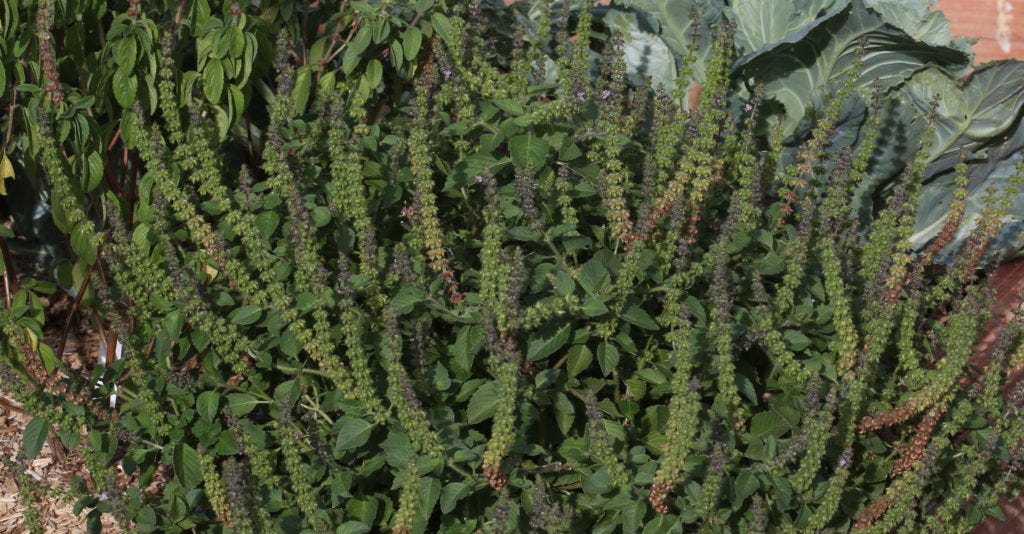
And just when I thought I was done with this essay on the origins of this Tulsi, I checked the web to see if any study had, yet, evaluated this ecotype – as many pharmacological, agronomic, botanical, etc. investigations rely on either seed marketing companies or official seed banks.
Both are a source of incredible botanical errors. This is not a rumor… but a proven fact.
Thus, I have just discovered the PI 652059 ecotype in the study analyzing the resistance capacities, of multiple ecotypes, to basil downy mildew. “Resistance Against Basil Downy Mildew in Ocimum Species”. [29] It is considered to be very resistant to mildew… which is simply because all forms of temperate Tulsi are.
The same resistance is true for ecotype PI 414201… and other ecotypes of this series (PI 414203, PI 414205) which are presented as Ocimum tenuiflorum. Could they also be temperate Tulsis?
This is, most likely, the case judging by the findings of the study, published in 2018, entitled “Variation in Growth and Development, and Essential Oil Yield between Two Ocimum Species (O. tenuiflorum and O. gratissimum) Grown in Georgia.” [53]
Indeed, this study states that the ecotypes named “Kapoor”, PI 414201, PI 414202, PI 414203, PI 414204, PI 414205, PI 652056 and PI 652059 present, all of them, the same type of leaves, the same high bio-mass productivity, the same very compact habit, the same very low rate in its essential oil… all characteristics that define a temperate Tulsi with red pollen.
The 2016 study by Simon and Vieira attributed 0.27% essential oil in the temperate Tulsi ecotype, PI 414204.
The ecotypes PI 414201, PI 414202, PI 414203, PI 414204, PI 414205, PI 652056 and PI 652059 are all presented as Ocimum tenuiflorum and, except the last one from the Maldives, they are listed in the USDA seed bank in Maryland.
A botanical listing error, with regard to this unknown Tulsi species, is easily explained by the fact that it has been marketed, for more than 40 years, under the name of “Sacred Basil”; by the fact that Ocimum tenuiflorum was formerly Ocimum sanctum – i.e., “Sacred Basil”; by the fact that the Ethiopian “Besobela” was marketed under the name of “Ethiopian Sacred Basil”.
The ecotype of “Kapoor” comes from Richo (Strictly Medicinal Seeds). I only notified Richo at the end of 2016 regarding this botanical error… as “Kapoor” is, strictly, Ocimum kilimandsharicum. Notwithstanding, Noelle Fuller, the person in charge of the study, having carried out her cultures, in Georgia, in 2015 and 2016, could not have been aware of this error.
However, she suspected it because she specifies, in conclusion that: « Unfortunately, there is a big confusion as for the origin of the cultivar Kapoor, and it is difficult to identify it botanically ».
Moreover, there is a form of genetic confirmation, in clade form, for some of these USDA ecotypes – PI 414201 and PI 414203 – in the study, from 2018, entitled “Population structure, genetic diversity and downy mildew resistance among Ocimum species germplasm.“ [23] Indeed, it is stated, in a very “mytho-genetic” jargon, that « Three F1 progenies of k3.1 accession 139 (“Spice”) hybridized with Ocimum basilicum k1.1 accessions – namely, 22 (RUSB_09), 6 (“DiGenova”) and 47 (MRI) – form a well-supported clade (0.938) with accessions 135 (PI 414201) and 136 (PI 414203) ».
Moreover, it is clearly stipulated that « Two additional USDA/GRIN accessions, PI 414201 (acc. 140) and PI 414203 (acc.141), are included in this clade and parentage is unknown. » These four ecotypes are listed as Ocimum tenuiflorum by USDA/GRIN – as I mentioned above. [79]
It is, also, this study that tried to hybridize the temperate Tulsi, called “Spice”, with the three varieties of Ocimum basilicum mentioned above. These researchers have even tried to cross the Tulsi “Spice” with the only variety of Ocimum basilicum totally resistant to mildew, namely Mrihani (MRI)… without success because the offspring were totally sterile.
They also tried to cross these three varieties of Ocimum basilicum with an ecotype of Ocimum kilimandsharicum without more success.
In conclusion, it seems reasonable, while waiting to cultivate again all these ecotypes – PI 414201, PI 414202, PI 414203, PI 414204, PI 414205, PI 652056 and PI 652059 – to affirm that they are forms of temperate Tulsi with red pollen and a very compact habit… and not of Ocimum tenuiflorum. The only doubt I have, for the moment, concerns PI 652056 that I found, in another study, with a eugenol chemotype and no trace of bisabolene. [120]
In fact, this discovery has considerable scientific implications – botanical, genetic, pharmacological, medicinal, etc.
As far as I was concerned, I immediately realized that the Croatian study – entitled “Molecular and chemical characterization of the most widespread Ocimum species” – which claimed to have discovered Bisabolene chemotypes in four ecotypes of Ocimum tenuiflorum – MAP01627, MAP00160, MAP01656, MAP01628 – had been completely mistaken.
In conclusion, I informed Professor Klaudija Carović-Stanko, from the University of Zagreb, that the section of her study that deals with the genetic placement of Ocimum tenuiflorum – in the great Ocimum tree – is completely wrong… as it deals with various ecotypes of the temperate Tulsi.
And this type of scientific error – for lack of authentic botanical authentication – spreads, like fire, as everyone refers to others to go with their thesis publication.
Thus the study, from 2015, entitled “Sources of variability in essential oil composition of Ocimum americanum and Ocimum tenuiflorum”, declines the various Bisabolene chemotypes proposed by Klaudija Carović-Stanko and her team. [83]
Thus the 2021 study entitled “A glance at the chemodiversity of Ocimum species: Trends, implications, and strategies for the quality and yield improvement of essential oil” [103], mentions Bisabolene chemotypes for Ocimum tenuiflorum and for Ocimum americanum whereas, in both cases, it is temperate Tulsi ecotypes that have been analyzed in the referred studies – as I also prove it for Ocimum americanum in my monograph on this species. [105]
Indeed, this Croatian team identified “β-bisabolene” in these four ecotypes at 51.98%; 26.68%; 25.89%; and 24.60%, respectively. [21]
Moreover, it would be a strong coincidence that four ecotypes of Ocimum tenuiflorum share the same Bisabolene chemotype – while this element is not common in this species. Moreover, their eugenol content varies, depending on the four ecotypes, from 0% to 3.1%.
It remains to be verified whether the ecotype of Ocimum tenuiflorum, analyzed in Iran, in 2013 – with equal parts Bisabolene, Eugenol and Eucalyptol chemotype in its essential oil – is really an ecotype of this species. [20]
These four ecotypes (MAP01627, MAP00160, MAP01656, MAP01628) are from the seed bank of the University of Zagreb, Croatia… and it is likely that they are from the USDA seed bank.
Why? Because seed banks, and botanical gardens, all over the world exchange seeds. When I created the Jardin Botanique de la Mhotte, in 1994, I exchanged a lot with botanical gardens all over the world.
Moreover, the Croatian team is not the only one to have been led astray by botanical dead ends. I just discovered a few studies which, evidently, analyzed the essential oil of temperate Tulsi ecotypes – thinking they were dealing with Ocimum tenuiflorum.
According to the Iranian study, from 2015, entitled “The Effect of Different Harvest Stages on the Quality and Quantity of the Essential Oil of Tulsi (Ocimum sanctum L.)”, the ecotype of Ocimum sanctum analyzed contained 7-10% β-bisabolene. [63]
Is this really an Ocimum tenuiflorum – or a Tulsi on Bisabolene mode?
The same question arises for the study, from 2014, entitled “Comparative Volatile Oil Composition of Three Ocimum Species from Western Himalaya)” which states that it analyzed an Ocimum tenuiflorum with 16.1% bisabolene. [71]
According to the 2005 study entitled “Composition of the Essential Oil of Ocimum in Poland During Vegetation”, the ecotype of Ocimum tenuiflorum analyzed contained 20.4% β-bisabolene and 6.9% trans-α-bisabolene – and 7% eugenol – at the end of growth. [64]
Is this really an Ocimum tenuiflorum – or a temperate Tulsi with the Bisabolene chemotype?
According to the study, from 2016, titled “Antimicrobial Activity of Tulsi (Ocimum tenuiflorum) Essential Oil and Their Major Constituents against Three Species of Bacteria”, the ecotype of Ocimum tenuiflorum analyzed contained 10.7% β-bisabolene and 16.7% α-bisabolene – in the flowers. [65]
Is this really an Ocimum tenuiflorum – or a temperate Tulsi with the Bisabolene chemotype?
According to the study, from 2012, entitled “Pharmacognostical, phytochemical and pharmacological variations in various species of Ocimum genus a review”, the analyzed ecotype of Ocimum tenuiflorum contained 13-20% of β-bisabolene and 4-7% of (E)-α-bisabolene. [104]
Is this really an Ocimum tenuiflorum – or a temperate Tulsi with the Bisabolene chemotype?
According to the Egyptian study, from 2016, entitled “Introduction of Ocimum tenuiflorum plant to the Egyptian cultivation”, the analyzed ecotype of Ocimum tenuiflorum contained 17.2% of β-bisabolene. [82]
Is it really an Ocimum tenuiflorum – or a temperate Tulsi with the Bisabolene chemotype? The question probably does not arise because the seed strain comes from the Californian seed company J. L. Hudson, Seedsman, which has the reputation of being one of the introducers of the temperate Tulsi, with red pollen, in the USA, in the 80s. Today, this catalog sells seed of temperate Tulsi by kilo (in organic) and it continues to present it as Ocimum sanctum.
Now, at the risk of asking a spicy question. Because of the present, proven and blatant cases of use of an Ocimum genetic resource of the “Temperate Tulsi” type – “Sacred Basil”, “Spice”, “Blue Spice” – instead of, officially, Ocimum tenuiflorum (strictly native to India), it would be interesting to know, exactly, the number of official scientific studies whose mission was to carry out very costly and complex investigations from ecotypes of Ocimum tenuiflorum which turned out to be, authentically, temperate “Tulsi” with spicy, woody, myrrh scents – in the Bisabolene mode… and originating from Ethiopia.
Fortunately, if we judge by the first 200 studies – out of 651 – presented by PubMed on the query “Ocimum tenuiflorum”, and of which I have consulted the names of the authors, they are, for the vast majority, studies carried out in Asia, and especially in India – that is to say in the heart of the tradition that worships the Tulsi Ocimum tenuiflorum.
Why? Because these studies relied directly on the USDA seed bank – or indirectly on the seed banks of botanical gardens and universities around the world in partnership with the USDA.
And, also, because these studies drew on the seed resources offered by US – and European – seed companies since 1994. And, certainly, all the seed companies in the USA which proposed, 30 years ago, and which continue to propose a “Sacred” basil – namely the temperate Tulsi, under the name of “Sacred Basil”, “Spice” and “Blue Spice” – have attributed to it the species Ocimum sanctum/Ocimum tenuiflorum. Indeed, this denomination is surrounded by a prestige – oh so deserved! More Spicy, Baby!
And this, in spite of the fact that they praise its exotic and vanilla fragrance, its compact habit, its resistance to cold, its very fast growth and flowering… all qualities, strictly speaking, that are antinomic to the intrinsic nature of an Ocimum tenuiflorum – growing in an environnement with a template “climate”.
It could not be otherwise because, on the one hand, the goal of a seed company is to sell seeds that are bought because they are grown with love. However, in North America, in most regions, as well as in Europe, the Tulsi Ocimum tenuiflorum is very difficult to cultivate because it needs a lot of heat, and for a long time, or a greenhouse. Tulsi Ocimum tenuiflorum only produces bio-mass in very warm conditions – or in a greenhouse.
Today, in order to verify what is happening in the USA, in the world of basil seeds, one only has to search on the Web, with the key words “Sacred, Basil, Seeds, Organic, Ocimum tenuiflorum”, to discover dozens of seed companies that continue to claim that the temperate Tulsi with red pollen – that they present, very clearly in photographs and descriptions – is an Ocimum tenuiflorum.
On the other hand, considering the extreme fame of the Besobila Ocimum in Ethiopia, it is easy to consider that they possess, for these Peoples, a “Sacred” character because, it is surely the reality… as for the various Tulsi in India. For these Peoples, this tempered Tulsi constitutes one of the bases of their food and their therapy – thus of their Life.
“Sacred”, at least, in its most sacred expression, namely “that confers Power”. In fact, the terms “sacred”, “sacrament”, “sacrifice”, etc., all come from the same etymology: “Sak” in Sanskrit, meaning “strength, power » – namely Power. What is “sacred”, for the Anthropos, generates a sharing of Power … with those who hold it, namely the Telluric Forces.
Thus, for the last 25 years, at least, there is a strong suspicion that a large part of the Western scientific studies on Ocimum tenuiflorum have been done on temperate Tulsi – for lack of authentic genetic resources.
Today, I would be inclined to propose to question all studies on Ocimum tenuiflorum when they have been carried out in Europe or North America – and even South America – in the absence of a related photograph allowing to authenticate the plant.
I thought, unfortunately, that studies on the species Ocimum tenuiflorum could be trusted when carried out in India – or in Thailand – by researchers living in the country, having access to living genetic resources, wild or cultivated, and having the possibility to have an authentic botanical determination worthy of the name…
… because Ocimum tenuiflorum is at the heart of the home of hundreds of millions of families in India – and it would be rare that a scientist in this country does not recognize this Tulsi.
However, my discoveries – presented in the next section – regarding studies done in India with temperate Tulsi instead of Ocimum americanum made me question a number of phenomena.
Thus, I discovered photographs of this ecotype from two blogs in India. A medicinal plant blog in the state of Manipur [78] and a commercial blog, for gardeners, full of atrocious advertisements and monstrous botanical errors [77]. In both these blogs, the temperate Tulsi is presented as Ocimum tenuiflorum.
One of the conclusions, from this botanical specific determination marasmus, is that it would be necessary to take back all the “scientific” studies, Western, which used the temperate Tulsi, since a quarter of century, instead of Ocimum tenuiflorum… in order to put back some biological, chemical, genetic, morphological clocks, on time.
And, above all, in order to gather precious informations, as to the nature of the temperate Tulsi, which were presented, in all clarity, for so many years… but under another name. Why? In order to argue, even better, about the necessity to give a species name to the Temperate Tulsi, because it seems that its morphological and agronomic characteristics were not enough to persuade the Western experts of the basil world…
Western experts of the basil world who, moreover, in the space of a quarter of a century, have never discovered that a serious botanical determination error invalidates a certain number of European and American studies on Ocimum tenuiflorum.
For example, let us start with this 2003 study entitled “Genetic Diversity of Basil (Ocimum spp.) based on RAPD Markers”. [56] In fact, everything described in this study about Ocimum tenuiflorum concerns an ecotype called “Sacred”, distributed by Nichols Gardens, and whose identity is clearly that of a temperate Tulsi – according to the photographs, and the description, of this seed company – despite the fact that it is presented as an Ocimum tenuiflorum. [57]
In this study, it is noticed that although Ocimum tenuiflorum and Ocimum selloi share the same section, they present only 36% of similarity – with regard to their genetic analysis. One can, therefore, deduce that the temperate Tulsi cannot be placed in the same botanical section including Ocimum tenuiflorum and Ocimum selloi – which is quite obvious to any astute botanist, or observer.
For example, next. There is an Australian study, entitled “Antimicrobial Activity of Tulsi (Ocimum tenuiflorum) Essential Oil and Their Major Constituents against Three Species of Bacteria” [98], in which the supposed ecotype of Ocimum tenuiflorum contains more than 27% bisabolene in its flowering tops and, strangely, very little in its essential oil.
Is it really an Ocimum tenuiflorum or a temperate form of Tulsi?
For example, again. According to the 1996 study “Essential oils of Ocimum gratissimum L. and Ocimum tenuiflorum grown in Andhra Pradesh” [106], Lawrence et al., in 1980, and Philip and Damodaran, in 1985, reported the existence of a Thai ecotype, of Ocimum tenuiflorum, containing 30% to 33.4% bisabolene.
Is it really an Ocimum tenuiflorum or a temperate form of Tulsi?
For example, once again. The 2015 Iranian study, “Chemical Compositions and Antimicrobial Activities of Ocimum sanctum L. Essential Oils at Different Harvest Stages”, analyzed an ecotype of Ocimum tenuiflorum and identified two major components in the leaves: eucalyptol and β-bisabolene at 20.99%; and three major components in the flowering tops: eucalyptol, eugenol and β-bisabolene at 18.76%. [118] The results of this study are echoed by another Iranian study, from 2020, “Constituents and Biological Activities Some of the Selected Ocimum Species: A Review”. [119]
Is it really an Ocimum tenuiflorum or a temperate form of Tulsi?
Another valuable information is provided in a study entitled “Estimation of nuclear DNA content of cultivated Ocimum species by using flow cytometry”. [55] According to this study, the DNA content of the temperate Tulsi ecotype – PI 652059 from the Maldives – is 2843 Mbp. This study, of course, claims to analyze an ecotype of Ocimum tenuiflorum but this error allows us to appreciate the genetic amplitude of the DNA of a temperate Tulsi ecotype – for what it is worth.
This Maldives ecotype is the one from the USDA seed bank that I grew this year – along with the “Spice” ecotype, from Canadian seed company Richter’s, and the “Tulsi. Sacred Basil” ecotype from the Kokopelli Association that I introduced in France in 1994. These three ecotypes are, strictly, identical – at least from a morphological point of view if not for the content of their essential oil. And still… because the perfume of these three ecotypes is just as intense and exotic.
This is a valuable information because the size of the genome of Ocimum tenuiflorum has been calculated several times… and it is not at all the same amplitudes of DNA.
In fact, according to the following publications, the genome of Ocimum tenuiflorum would be 5 to 6 times smaller than that of the temperate Tulsi.
Rastogi et al. in 2015, in their study “Unravelling the genome of Holy basil: An “incomparable” “elixir of life” of traditional Indian medicine” – with supporting photographs – state that the genome of Ocimum tenuiflorum is 386 Mbp. [58]
This information is confirmed, in the 2016 essay, “The Holy Basil (Ocimum sanctum L.) and its Genome” – with supporting photographs. [61]
Upadhyay et al. in 2015, in their study titled “Genome sequencing of herb Tulsi (Ocimum tenuiflorum) unravels key genes behind its strong medicinal properties” – with supporting photographs – state that the genome of Ocimum tenuiflorum is 374 mbp – for 61% coverage with an estimated 612 Mbp. [58]
According to the study “The complete chloroplast genome of Ocimum tenuiflorum L. subtype Rama Tulsi and its phylogenetic analysis”, the length of the complete circular chloroplast genome is 151,722 bp. [60] According to the study of Rastogi et al. the length of the complete circular genome of the chloroplast of Ocimum tenuiflorum is 142 524 bp. At that time, according to Rastogi, Ocimum tenuiflorum constituted the smallest (analyzed) genome in the Lamiaceae Family. Because the genome of Salvia miltiorrhiza is 151 328 bp.
We meet again Klaudija Carović-Stanko et al., from the University of Zagreb, in their 2010 study entitled “Genetic relations among basil taxa (Ocimum L.) based on molecular markers, nuclear DNA content, and chromosome number” [62]. This team of Croatian researchers used an ecotype of Ocimum tenuiflorum from Germany (MAP01628) and estimated the genome size of Ocimum tenuiflorum at 386 Mbp.
In contrast to her subsequent study, erroneously using four temperate Tulsi ecotypes, it would appear that, this time, it is a genuine ecotype of Ocimum tenuiflorum because the results, obtained by Klaudija Carović-Stanko, are consistent with other studies. One can assume that this ecotype of Ocimum tenuiflorum comes from the very ancient (and very extensive) seed bank of Gatersleben… which is much closer to India than Maryland, USA, is.
As for the basic chromosome number of Ocimum tenuiflorum, it was identified as 2 N = 16, 32 or 36 in Asia and as 2N = 72, by Paton, in the USA, in 1996. The question arises whether Paton, at that time, was aware of the prevailing botanical morass and whether he actually analyzed an ecotype of Ocimum tenuiflorum – and not an ecotype of temperate Tulsi.
And not to finish with the errors concerning Ocimum tenuiflorum. I have just discovered a very recent Ethiopian study – published in 2022 in the Bulletin of the Chemical Society of Ethiopia – which analyzed two populations belonging, allegedly, to Ocimum tenuiflorum, originating from Bishoftu (1920 meters above sea level) and Debre Berhan (2840 meters above sea level). The samples were purchased from the local market. The Bishoftu ecotype contained 31.38% E-α-bisabolene while the Debre Berhan ecotype contained 24.50% E-α-bisabolene and 0.55% (E)-γ-bisabolene. [108]
With such a Bisabolene chemotype, we are obviously dealing with two ecotypes not of Ocimum tenuiflorum but of Besobila growing in the Ethiopian highlands. The other predominant elements in the essential oil of these two ecotypes of temperate Tulsi are methylcyclohexane, eucalyptol and methyl-chavicol.
About the temperate Tulsi ecotypes, with red pollen, listed as Ocimum americanum in North America and Asia
Thus, today, if one prides oneself on botanical or scientific precision, it is imperative to be aware of the fact that temperate Tulsi has been the subject of Western studies on Ocimum tenuiflorum – for the precise reasons explained above – even though Western botanists (Alan Paton, James Simon, etc.) had assimilated it to an Ocimum americanum.
And I reiterate that this specific determination, Ocimum americanum, by these botanists, concerns as much the temperate Tulsi marketed in North America, and in Europe, as the temperate Tulsi, Besibola, from Ethiopia.
Therefore, it seems logical to suspect that the same kind of error may have occurred in Asia – that is, that some studies have focused on temperate Tulsi… instead of ecotypes of Ocimum americanum sp. americanum or sp. pilosum.
It is necessary to imagine that if, for thousands of years, Ocimum kilimandsharicum (originating from Kilimanjaro) is naturalized in India, that if ecotypes of Ocimum americanum sp. americanum or sp. pilosum (originating from Africa) are as well… it is the same with the temperate Tulsi originating from Ethiopia.
Thus, I would be inclined to be equally vigilant with regard to studies, coming from America, concerning certain ecotypes supposed to be Ocimum americanum – for example, when they are characterized by a high level of Bisabolene.
Why? Because, at the same time, I am finishing my next medicinal monograph on Ocimum americanum and I have, expressly, checked: Bisabolene is only rarely mentioned as a component of the essential oil of the ecotypes of Ocimum americanum sp. pilosum or Ocimum americanum sp. americanum in Africa – and even in Southeast Asia.
For example. A 2003 Purdue University study – by James Simon and Roberto Vieira – analyzed three ecotypes of Ocimum americanum. [68] The third one (Ocimum americanum sp. pilosum) was of the “Bisabolene” chemotype and contained 30-40% β-bisabolene – also with a high level of eucalyptol. But amazingly, this ecotype is PI 414204, from the USDA seed bank. So it is a temperate Tulsi ecotype.
It is, therefore, the same PI 414204, analyzed, in the study in Georgia, in 2015 and 2016… except that 13 years later, it is no longer an Ocimum americanum sp. pilosum but an Ocimum tenuiflorum. What should we do?
And the same for India or Nepal. Indeed, as Ocimum kilimandsharicum is well adapted, by its origins, to high Himalayan areas, or mountainous regions of southern India, so is the temperate Tulsi from Ethiopia which is well resistant, even, to temperatures below 0°C.
Thus, I discovered photographs of this ecotype, coming from Katmandu, in Nepal, presented by a botanist requiring its specific determination. In this ecotype in Nepal, the style is, sometimes, extremely long. [25] [26] I discovered some, again, on another botanical site. [76]
I am, therefore, in the process of checking with these Nepalese botanists whether the Ethiopian Tulsi, with its red pollen, is also dispersed in distant regions of Nepal – and not only in the Kathmandu region, in Bhaktapur and Gyaneswor, at an altitude of 1350/1500 meters. Why? Because I went to Nepal, several times, around 2010 – and also to Bhutan, once, invited by the Ministry of Agriculture to give a course on organic vegetable seed production…
I distributed tons of organic seeds, from the Kokopelli Association, while we were in the process of setting up a branch in Nepal, “Kokopelli Himalayas” – with the help of Stéphane Fayon, the director of the seed bank in Auroville, in Tamil Nadu, which we had created in 2000. These seeds were distributed in the greater Kathmandu region, in the greater Pokara Lake region and in Mustang. The « “Kokopelli Himalayas” branch did not exist for very long because our charming local partner did not share the same notions of ethics and transparency as ours!
Among these thousands of Kokopelli seed-packets distributed, free of charge, to Nepalese farmers, was, of course, the temperate Tulsi, with red pollen, which we have been distributing commercially, in France, since 1994. Thus, in Asia, the Kokopelli Association has distributed tens of thousands of seed-packets – including the tempered Tulsi with red pollen – in Nepal, India, Sri Lanka, Cambodia… and this, in a very structured way, because I was the very subject of these trips.
Moreover, multiple NGOs have been distributing Kokopelli’s seeds – as part of the “Seeds without Borders” program – for more than 20 years in Nepal and in many other poor countries in Asia, Africa and Latin America.
In conclusion, the endemic presence of the temperate Tulsi, with its red pollen, in the Himalayas needs to be verified by experienced botanists… in order to authenticate that it is not a very recent introduction. And if we judge by the following study, considering the number of analyzed chemotypes, it should be several naturalized ecotypes of temperate Tulsi.
In 2013, an Indian study analyzed 10 wild ecotypes of Ocimum americanum growing in the northwestern Himalayas and identified 6 chemotype groups. [69] Four ecotypes belonged to the “Bisabolene/Eugenol” group – with, respectively, 19.7% to 33.6% Bisabolene and 27.6% to 38.2% Eugenol. One ecotype belonged to the “Estragole/Bisabolene” group – with 28.9% estragole and 21.8% Bisabolene respectively.
With 5 ecotypes of Ocimum americanum, out of 10 ecotypes analyzed, having a Bisabolene chemotype, it is likely that this is the temperate Tulsi in one form or another. It should be noted, moreover, that one of these ecotypes comes from the plain while the other four grow at elevations between 1620 meters and 1950 meters.
As well. A 2014 Indian study analyzed an ecotype of Ocimum americanum growing in the northwestern Himalayas – namely in Ranikhet, in the state of Uttarakhand, at an altitude of 1900 meters. According to the analysis of its essential oil, it is a chemotype with almost 50% of Bisabolene – namely 29.06% of β-bisabolene and 17.49% of (E)-γ-bisabolene. [70]
Wouldn’t it be, rather, tempered Tulsi in one form or another?
As well. An Indian study, published in May 2022, analyzed wild plants of Ocimum americanum growing in the northwestern Himalayas, in the state of Uttarakhand – namely in Ranikhet, at 1900 meters above sea level and in Champawat at 1850 meters above sea level. For these two ecotypes, the level of β-bisabolene ranged from 14.46% to 29.74% while (E)-α-bisabolene ranged from 11.42% to 22.17%. [72]
Wouldn’t it be, rather, tempered Tulsi in one form or another?
Moreover, in Ethiopia, a study, from 2010, analyzed the composition of the essential oil of an ecotype of “Besobila” identified as an Ocimum americanum. Its major component was eucalyptol at 21.82% and followed by β-bisabolene at 15.93% and trans-α-bisabolene at 13.74% – making it a predominantly “Bisabolene” chemotype. [50]
It is clearly a form of tempered Tulsi – as it is called “Besobila”.
What’s more. In a 2018 study entitled “Product authenticity versus globalization – The Tulsi case”, it is discovered that an ecotype named “Vana 8258” is sometimes presented as an Ocimum americanum and sometimes as an Ocimum gratissimum and sometimes as an Ocimum tenuiflorum when classifying Ocimum in genetic clades. [84]
This is without mentioning the scale presented, in this study, for a series of photographs of blurred flowers… which is totally wrong.
But what is even more surprising is that it was included in the large clade of Ocimum basilicum, Ocimum americanum and Ocimum kilimandscharicum – far from Ocimum gratissimum.
The researchers of this study specify, in fact, that two commercial ecotypes of Ocimum gratissimum, “Vana”, arrived from Milan and that one of them gave them some trouble with the identification. One of these Ocimum “Vana” (Milanese) is found, by the way, in another study, from 2010, entitled “A comparative study of different DNA barcoding markers for the identification of some members of Lamiaceae.” [85]
And what is even more surprising is that the photographs, proposed for this ecotype (Milanese) present, most probably, an ecotype of Ethiopian temperate Tulsi, with white pollen.
If I were a Tulsi grower in the Milan area, I would opt for a temperate form of Tulsi (with red or white pollen) because the production is much more considerable – especially considering the very tropical Ocimum gratissimum. This was realized this year by a friend of mine, a distributor of medicinal plants in the north of Spain, who ordered by mistake the temperate Tulsi of Kokopelli, with red pollen, instead of Ocimum tenuiflorum, and who was so happy with this mistake – in terms of bio-mass production of Tulsi.
A Tempered Tulsi with spicy, woody, myrrh scents… in Bisabolene mode
Richo mentions, on its site, that the ecotype of temperate Tulsi, with the red pollen – marketed by Strictly Medicinal Seeds – is of chemotype “Eugenol”.
I assume that this determination is based on the above mentioned study of Noelle Fuller in Georgia… who was looking for the eugenol content in a collection of Tulsis, sent by Richo, and Ocimum tenuiflorum (supposedly) from the USDA. However, one only has to look at the table of eugenol levels, for all ecotypes, to discover that we know nothing about their major chemotypes. Eugenol is only present at 7% to 17% in the “Kapoor” ecotypes, PI 414201, PI 414202, PI 414203, PI 414204, PI 414205, PI 652056 and PI 652059 – at least for the 2015 growing season.
Indeed, Noelle Fuller expresses her very great amazement that, in the 2016 growing season, the eugenol level rose to 30% to 39%. This is really surprising, because, for example, the PI 414203 ecotype had 7% eugenol in 2015 and 39% in 2016. It is very rare that there is such a difference in the essential oil composition of the same ecotype grown in the same site.
That being said, a study, from 2014, highlighted the variability in the essential oil of the aforementioned ecotype, PI 652056, regarding its eugenol content, and its two other major components, depending on the date of harvest and growth. The changes are indeed drastic: for eugenol, from 25.3% to 51.5%; for β-caryophyllene from 1.2% to 25.4%; for trans-β-guaiene from 9.4% to 19.2%. Could this be a temperate Tulsi, with red pollen, of Eugenol chemotype? [54]
According to Noelle Fuller’s analysis, it is not, at least for 2015, as its Eugenol content is 14-27%, depending on the two years of cultivation.
As for the three temperate Tulsi ecotypes presented in a recent Ethiopian study of March 2021 – and described in a next section – with a very high bisabolene content, their eugenol content is, respectively, 13.96%; 12.08% and 7.4%.
It would be very interesting if Richo could carry out a precise and complete analysis of all the components of his essential oil, because, to date, the analyses concerning the various forms of this temperate Tulsi, have all attributed a “Bisabolene” chemotype – up to 33% of the essential oil.
And even more so, if we take into consideration the fact that this temperate Tulsi, with brick red pollen, is one, specifically speaking, with the three Ethiopian ecotypes, with white pollen, presented in a subsequent section. Indeed, these three Ethiopian ecotypes contain, respectively, 45.79%, 43.92% and 27.22% of Bisabolene.
For example. According to a Serbian study, from 2015, [11], an ecotype of this temperate “Tulsi”, under the name “Blue Spice”, was characterized by a “β-bisabolene” chemotype up to 23.8% – with, also, 7% trans-α-bisabolene.
In addition to β-bisabolene and trans-α-bisabolene, the predominant components, of its essential oil, were: eugenol (16.2%), eucalyptol (14.3%), estragol (11.8%) and α-trans-bergamotene (3.2%).
For example. According to James Simon’s study in the USA, in 1999, on about 40 accessions of Ocimum, the “Spice” ecotype – which he attributed, at that time, to Ocimum americanum sp. pilosum – contained 33% of bisabolene in addition to 32% of eucalyptol and 16% of estragole… without eugenol. James Simon specified that «A group of ornamental basil plants were selected and named for their characteristic aroma, including “Anise” (methyl chavicol), “Cinnamon” (methyl cinnamate), “Licorice” (methyl chavicol) and “Spice” (β-bisabolene). »
This ecotype was also characterized by a low essential oil content of 0.22%, the lowest in the study – while the highest contents were found in Ocimum kilimandsharicum (5.22%) and “African Blue” (Ocimum kilimandsharicum X Ocimum basilicum) with 2.34%. [39]
For example. A 2003 Purdue University study – by James Simon and Roberto Vieira – analyzed three ecotypes of Ocimum americanum. The third ecotype, PI 414204 – a temperate Tulsi from the USDA seed bank – was of the chemotype “Bisabolene” and contained 30-40% β-bisabolene. At the time, Simon attributed it, also, to Ocimum americanum sp. pilosum. [68] We will, later on
The β-bisabolene – a sesquiterpene – could it, perhaps, lead us down the path of identifying this “Blue Spice”/“Spice”/“Holy Basil”/“Temperate Tulsi” ecotype?
Bissabol, Bissa Bol and Bisabolenes
In the beverage industry, Bisabolene is characterized by a fruity, balsamic, lemon, myrrh, spicy, woody, green, banana fragrance. It is the β-bisabolene that is approved, in Europe, as a food supplement.
There are three isomers of Bisabolene: α-, β-, and γ-bisabolene.
In addition, between 1985 and 2020, 356 sesquiterpenoid compounds of the bisabolene type were identified in 24 botanical families, including the Lamiaceae, Asteraceae and Zingiberaceae
Etymologically, the class of Bisabolenes, takes its name from Bisabol. Bisabol, or Bissabol, or Bissa Bol (a Hindi term, then adopted in Arabic) is a famous resin produced by an African Myrrh tree, Commiphora guidotti – growing in Ethiopia and Somalia. Bisabol is also referred to as “Fragrant Myrrh”, “Sweet Myrrh” and “Opoponax”, as well as locally in Somali as “Xabak xadi” – pronounced “habak hadi”.
An ecotype of Commiphora guidotti, from Ethiopia, contains, for example, 22.2% cis-α-bisabolene, as a second component. [1]
This resin was described in 1852 by the surgeon Vaughan – in his article entitled “Notes upon the drugs observed at Aden, Arabia” – which he named “Bissa Bol”. According to his report, this resin was exported to China and India to be mixed with cattle feed to increase and improve milk production.
In Arabian lands, the other myrrh is the resin of the species Commiphora myrrha, locally called “Hirabol” or “Heera Bol” – and “Bola” in Hindi.
In addition to Commiphora guidotti, other species of the same genus – Commiphora erythrea [2], Commiphora kua [3], Commiphora africana – contain many elements of the Bisabolene class as major compounds.
An ecotype of Commiphora africana contains, for example, 61.6% α-oxobisabolene, 10% γ-bisabolene, 4% α-bisabolol and 3.4% β-bisabolene – i.e. almost 80% Bisabolene type elements.
However, from the point of view of the Industry – which is always a harmful and biocidal point of view – the plant world does not produce enough Bisabolene. Thus, for example, a study in February 2021, entitled “High-efficiency production of bisabolene from waste cooking oil by metabolically engineered Yarrowia lipolytica”, presented the chimeric production of Bisabolene from transgenic yeast of the species Yarrowia lipolytica. [66]
The genes for α-bisabolene, β-bisabolene and γ-bisabolene are from Vancouver Fir (Abies grandis), Ginger (Zingiber officinale ) and Sunflower (Helianthus annuus), respectively.
Abundance of Bisabolenes in Ethiopian Sacred Basil: Could the temperate Tulsi, with its red pollen, be of Ethiopian origin?
In Ethiopia, the traditional basils, very famous for their food and medicinal properties, are called “Besobela”, “Besobila”, “Besobla” and “Basobila”.
All these traditional names are in Amharic – an Ethiopian language which is just as Semitic, as per its linguistic origins, as Hebrew, Arabic, etc. Besobila is written በሶብላ.
It is very likely that this denomination is inspired by its perfume induced, partly, by a strong rate of bisabolene – that is to say, a very intense perfume such as that of the “Sweet Myrrh”…
It is very interesting to underline that the ecotype “Besobela” – proposed commercially on the Web – is presented as an “Ethiopian Sacred Basil”.
The “Besobela”, in addition to its immense medicinal properties, is one of the fundamental elements of Berber sauces. In addition, all parts of the “Besobela” – the leaves, flowers, fruits and tender stems – are dried, and ground into powder, to be used as condiments in the preparation of a spicy cooking butter – in addition to other condiment species. This special blend is said to increase the shelf life of this spiced butter… for up to fifteen years – without altering its flavor.
However, it would seem that this “Ethiopian Sacred Basil/Besobela” participates of the same approximations, and falsehoods, as the Sacred Basil with red pollen. Indeed, on the Web, the traders in seeds of the “Ethiopian Sacred Basil/Besobela” do not present at all the same photographs.
Many sellers – such as Experimental Farm Network [4] – present an ecotype that I call identical to the one I grow this year in my garden – namely Ethiopian ecotype PI 197442 from the USDA Seed Bank. This ecotype is characterized by 61.57% linalool, 19.4% geraniol and 8% eucalyptol. It strongly resembles the variety called “Siam Queen” because it is an ecotype of Ocimum basilicum sp. thyrsiflorum – namely Thai.
Moreover, our seed colleagues, from Southern Seed Exchange, USA, list an ecotype from nearby Eritrea, with characteristics reminiscent of the Ethiopian ecotype PI 197442, as being, unfortunately, an Ocimum gratissimum… which the shape of its leaves immediately invalidates. [5]
Another seller on the web – Grow Artisan – presents a photograph [6] of an ecotype whose foliage looks very similar to that of the temperate Tulsi with brick-red pollen – with a high level of bisabolene – except that it seems, according to the blurred photograph, that the pollen is white. This color means that this ecotype, commercialized under the name of “Ethiopian Sacred Basil/Besobela”, is one of the temperate forms of Tulsi that originated in Ethiopia – and that recently came from Ethiopia.
When these temperate Tulsis will be granted a species status, it will have to be characterized by two pollen colors. This seems plausible since according to some botanists, Ocimum kilimandscharicum would be characterized, sometimes, by a grey pollen color instead of the brick red color – which characterizes the majority of ecotypes of this species.
A very recent Ethiopian study of March 2021, entitled “Chemotypic Characterization of Ocimum basilicum L. Essential Oils for Ethiopian Genotypes” [40], analyzed the essential oil of six Ethiopian ecotypes of Ocimum: three which are clearly ecotypes of Ocimum basilicum sp. thyrsiflorum and three ecotypes whose photographs are identical to those offered by the Grow Artisan seed company.
The first important conclusion is that these last three ecotypes have a very high level of Bisabolene: they contain, respectively, up to 45.79%, 43.92% and 27.22% of bisabolene – in the form of β-Bisabolene and (Z)-α-Bisabolene.
The second important conclusion is that these researchers are totally wrong about the specific attribution to these three ecotypes of Ocimum basilicum… because they should be Ocimum americanum – strictly… at least, according to the new Ethiopian botanical classification, from almost a quarter of a century ago, and whose source of authentication is Alan Paton at Kew Botanic Garden.
Indeed, in his 1999 thesis entitled “Chemical Investigations of Three Ocimum Species of Ethiopia”, [43] Abebe Getachew presented the essential oils of three Ocimum species growing in Ethiopia. These were Ocimum basilicum sp. thyrsiflorum, Ocimum americanum (sp. americanum and sp. pilosum) and Ocimum lamiifolium. Namely, Ocimum americanum (sp. americanum and sp. pilosum) according to the new classification of Alan Paton… because they are both forms of Ethiopian Tulsi.
Traditionally, in Ethiopia, Ocimum basilicum sp. thyrsiflorum is called, “Ajuban” or “Ashkuti”.
What caught my attention, from the first paragraph – with regard to my quest for the origin of the red-pollinated temperate tulsi – was the traditional name given by Abebe Getachew to one of the three species, namely “Besobla”, which he attributed to the species Ocimum americanum in its two forms – sp. americanum and sp. pilosum.
As for Ocimum lamiifolium, it is called “Dama-Kesse”.
Moreover, in 1999, Abebe Getachew pointed out that the nomenclature had just changed because, previously, the two forms of “Besobla” were attributed, erroneously, to the species Ocimum basilicum. Indeed, these two “Besobla” were strictly identified as ecotypes of Ocimum americanum sp. americanum and Ocimum americanum sp. pilosum – both by Alan Paton, from the Kew Botanic Garden, UK, and by the National Herbarium of Denmark.
Obviously, this new botanical classification has not passed into the mainstream because, for example, the July 2016 Spice India magazine, in one of its articles “In Search of Spices and Herbs in Ethiopia” [44], refers to “Besibola” as an Ocimum basilicum.
In fact, this botanical error goes back a long way, as it can be found in Paulos Cornelis Maria Jansen’s renowned book (1981), “Spices, condiments and medicinal plants in Ethiopia, their taxonomy and agricultural significance” – which is out of print. [49] On page 87, the botanical illustration of an Ethiopian basil specifically identifies it as an Ocimum basilicum, whereas the illustrations and descriptions characterize it, in fact, as an Ocimum americanum.
This is an illustration characterizing basils of what Jansen calls the “Basobila” group – another name for “Besobla” or “Besibola”. Jansen refers to the fact that he discovered that some of these plants, in the second year, started growing and flowering again.
Indeed, the illustrations, in this book of Jansen, clearly show morphological characteristics of Ocimum americanum: the base of the gynobasic style, the shape of the calyx, the amplitude of the calyx as well as the heart shape of the anthers – whereas the anthers of Ocimum basilicum are reniform.
On page 109 of the essay “Reproductive Ecology of Ocimum americanum and Ocimum basilicum. Lamiaceae) in India” (1989), [52] the author, Jacob Solomon Raju Aluri, of Andhra University, presents botanical illustrations of Ocimum basilicum and Ocimum americanum which confirm Jansen’s botanical error.
Botanical illustrations of Ocimum americanum are, also, available in a few studies – including the Brazilian study, from 2008, entitled “Biologia floral e mecanismos reprodutivos de Ocimum canum.” [45]
As for Jansen’s descriptions, they clearly highlight, again, morphological characteristics of Ocimum americanum. Thus, according to the ecotypes: the gynobasic style is between 6 mm and 8.5 mm long; the stamens are slightly hairy at the base; the corolla is between 5.5 mm and 7 mm long; the pedicels are between 2 mm and 3.5 mm long; etc.
At this point in the presentation, it should again be pointed out that a quarter of a century ago, Temperate Tulsi was attributed to Ocimum americanum… for want of a better name. Indeed, Jansen’s descriptions, which I just presented, are relatively correct – at least, as to the morphology of the temperate Tulsi flower.
Indeed, I think we can say that the morphology of the temperate Tulsi flower is relatively identical to that of the Ocimum basilicum flower and to that of the Ocimum americanum flower (in its two subspecies) – as well as to that of the Ocimum kilimandsharicum flower. It’s all a question of size, amplitude – or else, question of the base of the style or the shape of the anthers.
And these last characteristics (style and anthers) are not easy to establish – even with a good macro camera… because you have to dissect to get to the base of the style. Or live in a windless area.
For the moment, I would describe, for the temperate Tulsi, an anther much less reniform than the one of Ocimum basilicum – and especially of less indentation at the junction with the stamen net.
Thus, from the point of view of flower morphology, I would be inclined to propose to place the temperate Tulsi in the same section Ocimum of the subgenus Ocimum of the genus Ocimum – according to Alan Paton’s classification – in very good company, therefore, of Ocimum basilicum, Ocimum americanum and Ocimum kilimandsharicum.
On the other hand, Jansen’s descriptions are not correct as to the description of the temperate Tulsi, which we know, in the West. It is not 75 cm high – but rather 35/40 cm. Its inflorescences are not 30 cm long – but rather 15 cm.
Obviously, if Jansen describes, very precisely, one of the Ethiopian Besobila forms, it is not the one we know with a very compact habit. On the other hand, the photographs offered by two spice companies in Ethiopia – mentioned earlier – show much larger plants – and with greater spacing between the whorled glomerules of mauve flowers, as described by Jansen.
What surprised me a lot, in Jansen’s description, is the color of the anthers: white or orange (brick red) – meaning that the color of the pollen is white or orange (brick red). What are we to conclude from this?
Is the temperate Tulsi, with brick red pollen, of Ethiopian origin?
Is the temperate Tulsi, with red pollen, one of the forms of Besobela? Indeed, according to Abebe Getachew’s dissertation, the name “Besobla” applies to two botanical forms in Ethiopia.
However, in the above-mentioned thesis of Abebe Getachew, there is no mention of bisabolene in the three ecotypes of “Besobila” – which are specified as Ocimum americanum – as he only gives the first two elements composing the determined chemotypes. However, Abebe Getachew did not perform a complete analysis of the essential oils in 1998 (sometimes only 60%) and, moreover, some of the compounds are labelled as unknown. And this is without mentioning the fact that there could exist, in Ethiopia, ecotypes of Ocimum americanum sp. americanum and Ocimum americanum sp. pilosum which have nothing to do with the traditional “Besobila”.
Could it be that these two forms of Besobela are each characterized by a different pollen color: white or brick red?
In this case, the three ecotypes presented in the above mentioned Ethiopian study of March 2021 would be a temperate form of Tulsi with white pollen and a very high bisabolene content: 45.79%, 43.92% and 27.22% of bisabolene – in the form of β-Bisabolene and (Z)-α-Bisabolene.
Could it be that Alan Paton, in 1999, considered both the temperate Tulsi, with brick-red pollen – (introduced as “Sacred Basil” in the USA in the 80’s) – and the two ecotypes of “Besobla” shipped from Ethiopia, at the end of the century, as Ocimum americanum – as an emergency measure?
Indeed, let’s remember that according to the Taiwanese study, of 2013, the “Spice” and “Blue Spice” ecotypes – namely the temperate Tulsi – were their own separate group, genetically speaking.
May I propose, as a tentative conclusion, in order to answer all these questions, a first clue of importance? The Ethiopian company, Damascene Essential Oil, is marketing 10 tons, for the year 2021/2022, of dried Besobila – per 100 g, 250 g, 1 kg and 5 kg. [47] This dried and powdered Besobila is advertised as an Ocimum basilicum but the proposed photographs are very clear and show, without any doubt, a temperate Tulsi ecotype with mauve and white flowers and brick red pollen.
As a second clue of importance. The Ethiopian company, Brundo Ethiopian Spice Company, proposes on its Fakebook, photographs of the Besobila/Bessobela (with red pollen) that it markets. [67] It is, strictly, the temperate Tulsi.
It would seem that the Bisabolene trail has led us to the possible geographical source of Temperate Tulsi – namely Ethiopia!!!
Besides, isn’t it logical that such a basil with a compact habit, and with a good resistance to the cold, comes from the African regions of altitude? And part of Ethiopia is located at about 2300/2500 meters above sea level… with a temperate climate and sometimes morning frosts.
The temperate Tulsi, with red pollen, is native of the Ethiopian high plateaus: it is a high altitude Tulsi! «Tulsi Tulana Nasti Ataeva Tulasi».
It remains to be proved, now, if these ecotypes of Ethiopian Sacred Basil, or temperate Tulsi, are really Ocimum americanum… or if it is another species that has not yet, at least officially, acquired this rank.
Even today, in Ethiopia, some botanists are not embarrassed and consider “Besobela” as an Ocimum sp, i.e. not recognized as a species – both observationally and existentially.
This is the case of a 2014 Ethiopian ethnobotanical study of the West Shoa region, which considers that the denomination “Basobila” refers perhaps to three species: two wild, or half-wild, and one domesticated… which would be Ocimum basilicum. [48]
Bisabolenes in other species of Ocimum… or botanical misidentifications?
There are three Ethiopian studies that claim to have discovered other Ethiopian ecotypes of Ocimum with high levels of Bisabolene in their essential oil. However, in the course of writing this essay, and in the course of discovering numerous botanical errors in studies published in scientific journals, I have some reservations about the real identification of these ecotypes.
It is true that these botanical errors do not invalidate the conclusions of these studies… but they do invalidate the subject.
For example, one study, from 2017, highlighted 29.52% β-bisabolene followed by 14.57% caryophyllene, 14.29% elemicin and 11.45% germacrene D., in a local ecotype of Ocimum lamiifolium. [46]
I have not found any other mentions of bisabolene, in the essential oil of other ecotypes of Ocimum lamiifolium – but concede that studies are few regarding this species.
For example, one study, from 2016, highlighted 10% α-bisabolene followed by 22% α-pinene, 21% eugenol, 11% α-cubebene, etc, in an Ethiopian ecotype of Ocimum urticifolium – namely Ocimum suave and, now, Ocimum gratissimum sp. gratissimum. [99]
Thus, a study, from 2003, highlighted a level of 19.02% of β-bisabolene followed by 14.05% of β-caryophyllene, in the essential oil of the flowers of an Ethiopian ecotype of Ocimum urticifolium – namely Ocimum suave and, now, Ocimum gratissimum sp. gratissimum. [41]
According to these studies, the analyzed ecotypes of Ocimum gratissimum sp. gratissimum grow naturally in the highlands of Ethiopia – i.e. at 2200/2300 meters altitude. Wouldn’t there be a problem of identification, at least for these two last analyzed ecotypes, because, normally, in Africa, Ocimum gratissimum sp. gratissimum thrives between 400 and 1600 meters of altitude?
It must be pointed out again that the temperature can be cold on these Ethiopian plateaus. If the temperate Tulsi resists a few degrees below 0°C, it is probably not the same for Ocimum gratissimum sp. gratissimum which is a much more tropical species.
I have the same cautious reservations with regard to a “eugenol/bisabolene” chemotype, of Ocimum kilimandscharicum, which was identified in India, in Lucknow, with 32% eugenol, 15.4% β-bisabolene and 10.9% (E)-α-bisabolene – in addition to 10.2% estragol and 8.2% eucalyptol.. [15]
The question arises again whether this is not a botanical misidentification because Ocimum kilimandscharicum, like temperate Tulsi, has a brick red pollen, strong aromas, resistance to cold, a predilection for highlands and a perennial nature … And this, especially since this study was conducted in Uttarakhand, the same region where local chemotypes of temperate Tulsi have been analyzed, in several studies, instead of Ocimum americanum.
As for the presence of Bisabolene in Ocimum kilimandscharicum, a study, from Kenya, from 2020, presents two ecotypes, one of which has 3.32% β-bisabolene and the other with 1.82% β-bisabolene and 0.76% α-bisabolene – following the analysis of the volatile compounds of its smoke. [117]
To conclude this topic, elements of the Bisabolene group have been identified, at lower levels, in a number of varieties of Ocimum basilicum or ecotypes of Ocimum americanum.
Thus, in 2020, CIMAP registered a new variety of Ocimum basilicum, named “CIM Sukhda” – developed for South Indian agriculture – with an oil content of 0.53% and a productivity of 105 kg per hectare. Its chemotype is “linalool”, at about 80%, with about 4% bisabolene, and as much citral, as major compounds.
This variety was obtained from the discovery in 2013 of a natural hybrid in a crop of Ocimum basilicum, Ocimum americanum sp. americanum and Ocimum americanum sp. pilosum. [27]
According to the pharmacological literature, bisabolene has also been identified in a “limonene” chemotype of Ocimum basilicum from Cameroon (N-bisabolene at 0.3%); in a very “lemony” ecotype, at 85%, from “New Guinea” (cis-α-bisabolene at 3.8%); in an ecotype of Ocimum x. citriodorum – at 11% [13]; in the variety “Lime” (at 8.9%) and in the variety “Lemon” (at 10%).
In Thailand, in 2007, with 1.91% (Z)-α-bisabolene in an ecotype of Ocimum americanum. [107]
It has been identified – in very small levels of about 1% – in some commercial varieties of Ocimum basilicum such as Dark Opal, Purple Ruffles, Green Ruffles, Mammoth, Cinnamon, Thai.
In conclusion, at this point in my investigations, I have found six studies identifying bisabolene, in essential oils of the species Ocimum gratissimum, which seem to be trustworthy as to their botanical identification.
In Cameroon, Bali, in 2012, an ecotype of Ocimum gratissimum sp. gratissimum was analyzed with 21.6% β-bisabolene – 33% eugenol and 18% elemicin. [100]
In Cameroon, in Battak in 2022, an ecotype of Ocimum gratissimum sp. gratissimum was analyzed with 19.10% β-bisabolene. [110]
In Cameroon in 2016, an ecotype of Ocimum gratissimum sp. gratissimum was analyzed with a Eugenol/Bisabolene chemotype. [111]
In Brazil, an ecotype of Ocimum gratissimum (leaves) was analyzed, in 2012, with 73% eugenol and 18.3% β-bisabolene. This ecotype has been the subject of two analyses involving anesthesia in Rhamdia quelen fish. [101] [109]
In Brazil, an ecotype of Ocimum gratissimum (leaves) was analyzed, in 2005, with 57.82% eugenol and 17.19% (Z)-α- bisabolene. This ecotype was the subject of analysis for its fungicidal activity against Cryptococcus neoformans. [113]
In India, in Uttarakhand, an ecotype of Ocimum gratissimum sp. gratissimum was analyzed with 29.52% β-bisabolene – in addition to 11.33% estragol and 9.75% eucalyptol. [114]
And, also, at very small levels of Bisabolene, in various ecotypes of Ocimum gratissimum. In Benin with 0.73% of β-bisabolene. [115] In India, in Andra Pradesh, with 0.10% β-bisabolene. [116] In Kenya with 0.74% β-bisabolene. [112]
Medicinal Properties of the Ethiopian Tulsi and Bisabolenes
It should be noted that, according to the above-mentioned Serbian study, temperate Tulsi, under the name “Blue Spice”, has the highest antioxidant capacity (IC50 = 0.03 µg/mL) of the 12 varieties analyzed. Its essential oil content, on the other hand, is the lowest with, only, 0,65% – while the variety Purple Opal contained 1,90%. Various analyses have mentioned the low productivity in essential oil of this Tulsi.
In this study, the antioxidant activity of this form of temperate Tulsi, under the name “Blue Spice”, is mainly due to its high level of β-bisabolene, eugenol and trans-α-bisabolene.
According to an Ethiopian study, mentioned above, [50] the anti-oxidant activity of temperate Tulsi is very strong… and this explains its ability to preserve spiced butter for about fifteen years.
It is necessary, however, to specify that the temperate Tulsi is not the only medicinal/aromatic plant. Some Ethiopian ethnic groups use a dozen species for spiced butter and fifteen species for ghee – clarified butter… which can be kept forever.
For example, in the West Showa districts of Ethiopia, here are some of the species used in the composition of these butters: Nigella (Nigella sativa), Turmeric (Curcuma domestica), Cinnamon (Cinnamomum verum), Coriander (Coriandrum sativum), Fenugreek (Trigonella foenum), Garlic (Allium sativum), Ginger (Zingiber officinale), African Cardamom (Aframomum angustifolium), Ammi (Trachyspermum ammi), Black pepper (Piper nigrum)…
According to a very technical Indian study, mentioned above, [72] the anti-oxidant, and anti-inflammatory, activity of temperate Tulsi is very strong.
This study also mentions Mohsen Kazemi’s 2014 study that highlighted the strong antioxidant activity of β-bisabolene. [73]
A June 2020 study determined the carotenoid content of the flowers of three Basilics: 51.59µg/g for the “Blue Spice” ecotype; 68.33µg/g for the “Cinnamon” variety; 81.86µg/g for the “Thai Lemon” variety – in fresh weight. [7] It also determined their anthocyanin content: 0.16 mg ME/g for the “Blue Spice” ecotype; 0.06 mg ME/g for the “Cinnamon” variety; 0.03 mg ME/g for the “Thai Lemon” variety – fresh weight.
A Serbian study, from July 2014, determined the mineral composition of 13 ecotypes of Basil. According to this study, the “Spice” ecotype (of chemotype “Bisabolene”) possessed the second place for iron with 1507 mg/kg – the highest at 3576 mg/kg (“Greek”) and the lowest at 202 mg/kg. [41] It was the “Lettuce Leaf” variety that was in third place with 1126 mg/kg.
This ecotype “Spice” fixed very little lead but, on the other hand, fixed very easily chromium, cadmium, nickel. It is preferable to grow this Tulsi in organic gardening because it is a necro-accumulator species – like all Tulsis. It accumulates poisons from the agricultural industry (and others), in all its tissues, except, allegedly, in the compounds of its essential oil – according to what the perfume industry says… which is very convenient, especially for themselves.
Bisabolene has, pharmacologically speaking, an anti-bacterial, anti-inflammatory, anti-malarial and cytotoxic activity. For example, it is known to be cytotoxic against breast cancer. [17]
According to the conclusions of this study, from 2015: «In summary, we have identified an anticancer agent from opoponax essential oil that exhibits specific cytotoxicity to human and murine breast tumor cells in vitro and in vivo, warranting further investigation of the use of β-bisabolene in the treatment of breast cancers.»
Thus, in 2022, a study validated the anti-carcinogenic potential of Xanthorrhizol, a sesquiterpenoid of the Bisabolene type isolated from Java Curcuma, Curcuma xanthorrhiza, against cancers of the breast, cervix, colon, liver, lung, mouth, esophagus and skin. Moreover, this study has described its other pharmacological activities: anti-oxidant, anti-inflammatory, anti-microbial and anti-diabetic, in addition to a protective effect on several organs. [32]
A study, of 2015, had already declined, precisely, the anti-microbial anti-oxidant, anti-inflammatory, estrogenic, anti-estrogenic, anti-hyperglicemic, anti-hypertensive, hepato-protective, nephro-protective activities of this Bisabolene. [36]
Thus, in 2015, new sesquiterpenoids, of the Bisabolene type, were isolated from the roots of the climbing Ylang-Ylang, Artabotrys hexapetalus. Their cytotoxic activity has been validated against various types of cancer: colon, liver, ovary, lung, stomach. [28]
Thus, in 2015, a study highlighted the cyto-toxic activity of γ-bisabolene against squamous cell carcinoma. [34]
For example, in 2012, a study highlighted the anti-seizure activity of sesquiterpenoids, of the Bisabolene type, isolated from a species of Curcuma, Curcuma longa. [31] Their anti-epileptic activity was confirmed by a 2021 systemic review entitled “Mechanism of Curcuma longa and Its Neuroactive Components for the Management of Epileptic Seizures: A Systematic Review.” [33]
Immortelle (Helichrysum italicum) is known, among other benefits, for its anti-convulsant activity. Some of its ecotypes may contain 20% β-bisabolene in their essential oil.
The anti-bacterial activity of Bisabolene has been validated against Staphylococcus aureus. [18].
The anti-bacterial activity of Blue Spice has been validated against: Bacillus cereus, Listeria monocytogenes, Micrococcus flavus, Pseudomonas aeruginosa, Salmonella typhimurium, Escherichia coli, Enterococcus faecalis.[11]
According to this Serbian study, Blue Spice was the most active Basil, of the twelve analyzed, against the following bacteria: Bacillus cereus, Micrococcus flavus, Pseudomonas aeruginosa and Salmonella typhimurium.
The anti-fungal activity of Blue Spice has been validated against: Aspergillus fumigatus, Aspergillus niger, Aspergillus versicolor, Aspergillus ochraceus, Penicillium funiculosum, Penicillium ochrochloron and Trichoderma viride. [11]
Resistance of Ethiopian Tulsi to Basil Blight, Peronospora belbahrii
A 2014 study entitled “Morphological Characteristics and Susceptibility of Basil Species and Cultivars to Peronospora belbahrii” found that the ecotypes named “Spice”, “Blue Spice” – and even “Blue Spice F1” which is no longer offered commercially and which was, for sure, a fake hybrid F1 – are not very susceptible to Basil blight, which has been causing disasters in vegetable growers all over the world for a number of years, and all the more so because of the extreme fragility of the entire agricultural system based on chemical fertilizers and biocides. [19]
In this study, there was strictly no sporulation of downy mildew in these three “Spice” ecotypes.
In this study, the researchers were looking for a correlation between the susceptibility to mildew of basil and the number of stomata per square millimeter. Thus, the non-susceptible ecotypes “Spice”, “Blue Spice”, and “Blue Spice F1” were characterized by 117, 107, and 101 stomata per square millimeter, respectively – three times less than the types with the maximum number of stomata.
Furthermore, it seems established that oval-shaped stomata – which characterize “Spice”, “Blue Spice”, and lemon ecotypes – are much less susceptible, if at all, to Peronospora belbahrii… compared to types with rounded stomata.
The already mentioned 2015 Israeli study entitled “Resistance against Basil Downy Mildew in Ocimum species” [29] also highlighted the low susceptibility of the ecotypes “Spice” and “Blue Spice”, to Peronospora belbahrii.
According to this study, which deals with 113 accessions of Ocimum, the scores, of resistance, of the ecotypes “Spice” and “Blue Spice”, are, respectively, 0.15 and 0.30 – on the scale of 0 to 4. It should be noted, also, that, according to this study, the ecotypes “Spice” and “Blue Spice” are not determined specifically but “Ocimum sp.”
In fact, the resistance of the “Spice” and “Blue Spice” ecotypes has been identified in several studies [37] and as early as 2010 – for example, by McGrath et al. in the study entitled “Susceptibility of Basil Cultivars and Breeding Lines to Downy Mildew.” [22] The photograph on page 1417 of the September 2010 issue of HortScience clearly shows the brick-red color of their pollen.
In this study, the lemon ecotypes – “Sweet Dani”, “Lemon”, “Lime” and “Mrs Burn” – as well as the Ocimum basilicum varieties “Red Rubin” and “Sweet Aden”, were assessed as low susceptibility.
Thus, due to its total resistance to Basil blight, the “Spice” ecotype, according to a 2018 study, was used to create hybrids with Ocimum basilicum, some of which were resistant… but sterile. [23]
The researchers of this study also crossed the ecotype “Kivumbasi Lime”, and an ecotype of Ocimum kilimandsharicum, with Ocimum basilicum… with no more success because the inter-specific hybrids were sterile.
It was, also, used, in 2014, as an Ocimum americanum species, in an experiment-along with Ocimum basilicum and Ocimum x. citriodorum-whose objective was to discern whether susceptibility to downy mildew begins to occur at cotyledon emergence. [51]
«Tulsi Tulana Nasti Ataeva Tulasi».
Tulsi is Incomparable… in the sense that she cannot be compared to anything else. Because of this attribute, she is a manifestation of the Heavenly Mother on Earth.

